Brand Management: Building and Managing Brands Overtime
VerifiedAdded on 2023/01/19
|21
|6909
|40
AI Summary
This study focuses on brand management and how brands are built and managed over time. It explores the importance of brand equity, brand perception, and brand strategy. It also discusses brand portfolio strategies and the advantages and disadvantages of different brand management approaches. The case study of Tesco plc is used to illustrate these concepts.
Contribute Materials
Your contribution can guide someone’s learning journey. Share your
documents today.

BRAND MANAGEMENT
Secure Best Marks with AI Grader
Need help grading? Try our AI Grader for instant feedback on your assignments.

Table of Contents
INTRODUCTION...........................................................................................................................3
LO 1.................................................................................................................................................3
Building and managing brands overtime.....................................................................................3
LO 2.................................................................................................................................................7
Brand portfolio strategy...............................................................................................................7
LO 3...............................................................................................................................................12
Brand extension and leveraging.................................................................................................12
LO 4...............................................................................................................................................14
Measuring brand value...............................................................................................................14
CONCLUSION..............................................................................................................................18
REFERENCES..............................................................................................................................19
INTRODUCTION...........................................................................................................................3
LO 1.................................................................................................................................................3
Building and managing brands overtime.....................................................................................3
LO 2.................................................................................................................................................7
Brand portfolio strategy...............................................................................................................7
LO 3...............................................................................................................................................12
Brand extension and leveraging.................................................................................................12
LO 4...............................................................................................................................................14
Measuring brand value...............................................................................................................14
CONCLUSION..............................................................................................................................18
REFERENCES..............................................................................................................................19
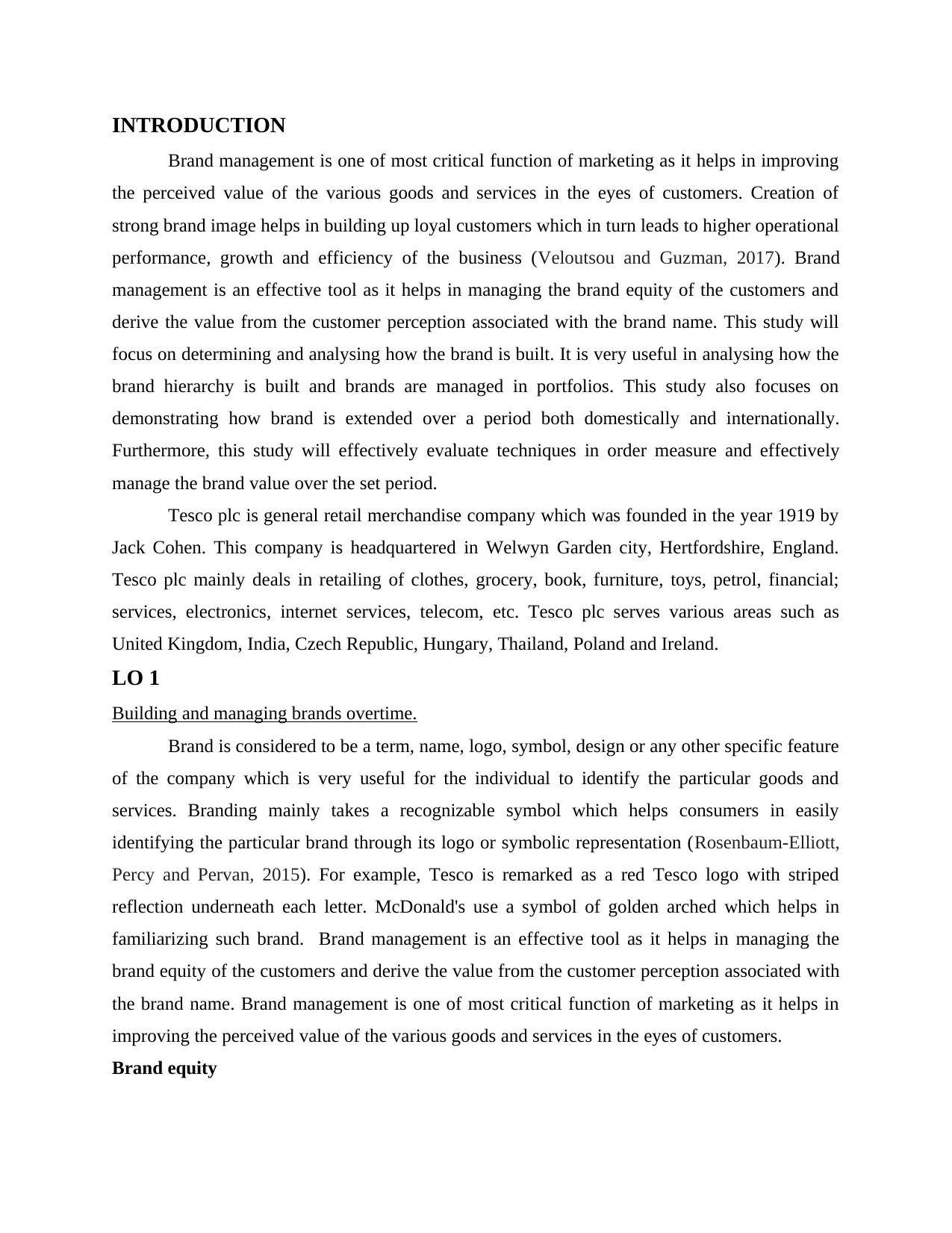
INTRODUCTION
Brand management is one of most critical function of marketing as it helps in improving
the perceived value of the various goods and services in the eyes of customers. Creation of
strong brand image helps in building up loyal customers which in turn leads to higher operational
performance, growth and efficiency of the business (Veloutsou and Guzman, 2017). Brand
management is an effective tool as it helps in managing the brand equity of the customers and
derive the value from the customer perception associated with the brand name. This study will
focus on determining and analysing how the brand is built. It is very useful in analysing how the
brand hierarchy is built and brands are managed in portfolios. This study also focuses on
demonstrating how brand is extended over a period both domestically and internationally.
Furthermore, this study will effectively evaluate techniques in order measure and effectively
manage the brand value over the set period.
Tesco plc is general retail merchandise company which was founded in the year 1919 by
Jack Cohen. This company is headquartered in Welwyn Garden city, Hertfordshire, England.
Tesco plc mainly deals in retailing of clothes, grocery, book, furniture, toys, petrol, financial;
services, electronics, internet services, telecom, etc. Tesco plc serves various areas such as
United Kingdom, India, Czech Republic, Hungary, Thailand, Poland and Ireland.
LO 1
Building and managing brands overtime.
Brand is considered to be a term, name, logo, symbol, design or any other specific feature
of the company which is very useful for the individual to identify the particular goods and
services. Branding mainly takes a recognizable symbol which helps consumers in easily
identifying the particular brand through its logo or symbolic representation (Rosenbaum-Elliott,
Percy and Pervan, 2015). For example, Tesco is remarked as a red Tesco logo with striped
reflection underneath each letter. McDonald's use a symbol of golden arched which helps in
familiarizing such brand. Brand management is an effective tool as it helps in managing the
brand equity of the customers and derive the value from the customer perception associated with
the brand name. Brand management is one of most critical function of marketing as it helps in
improving the perceived value of the various goods and services in the eyes of customers.
Brand equity
Brand management is one of most critical function of marketing as it helps in improving
the perceived value of the various goods and services in the eyes of customers. Creation of
strong brand image helps in building up loyal customers which in turn leads to higher operational
performance, growth and efficiency of the business (Veloutsou and Guzman, 2017). Brand
management is an effective tool as it helps in managing the brand equity of the customers and
derive the value from the customer perception associated with the brand name. This study will
focus on determining and analysing how the brand is built. It is very useful in analysing how the
brand hierarchy is built and brands are managed in portfolios. This study also focuses on
demonstrating how brand is extended over a period both domestically and internationally.
Furthermore, this study will effectively evaluate techniques in order measure and effectively
manage the brand value over the set period.
Tesco plc is general retail merchandise company which was founded in the year 1919 by
Jack Cohen. This company is headquartered in Welwyn Garden city, Hertfordshire, England.
Tesco plc mainly deals in retailing of clothes, grocery, book, furniture, toys, petrol, financial;
services, electronics, internet services, telecom, etc. Tesco plc serves various areas such as
United Kingdom, India, Czech Republic, Hungary, Thailand, Poland and Ireland.
LO 1
Building and managing brands overtime.
Brand is considered to be a term, name, logo, symbol, design or any other specific feature
of the company which is very useful for the individual to identify the particular goods and
services. Branding mainly takes a recognizable symbol which helps consumers in easily
identifying the particular brand through its logo or symbolic representation (Rosenbaum-Elliott,
Percy and Pervan, 2015). For example, Tesco is remarked as a red Tesco logo with striped
reflection underneath each letter. McDonald's use a symbol of golden arched which helps in
familiarizing such brand. Brand management is an effective tool as it helps in managing the
brand equity of the customers and derive the value from the customer perception associated with
the brand name. Brand management is one of most critical function of marketing as it helps in
improving the perceived value of the various goods and services in the eyes of customers.
Brand equity
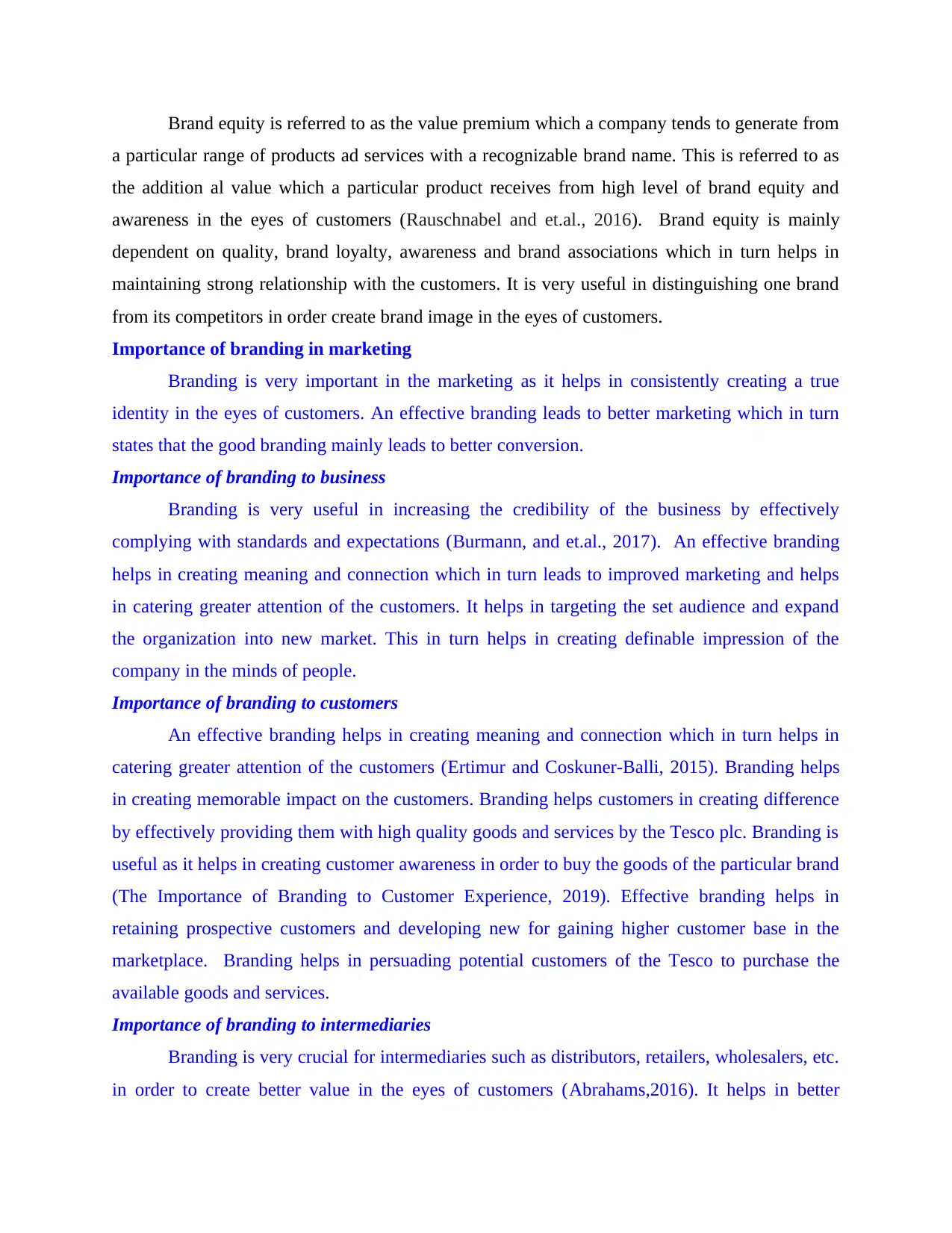
Brand equity is referred to as the value premium which a company tends to generate from
a particular range of products ad services with a recognizable brand name. This is referred to as
the addition al value which a particular product receives from high level of brand equity and
awareness in the eyes of customers (Rauschnabel and et.al., 2016). Brand equity is mainly
dependent on quality, brand loyalty, awareness and brand associations which in turn helps in
maintaining strong relationship with the customers. It is very useful in distinguishing one brand
from its competitors in order create brand image in the eyes of customers.
Importance of branding in marketing
Branding is very important in the marketing as it helps in consistently creating a true
identity in the eyes of customers. An effective branding leads to better marketing which in turn
states that the good branding mainly leads to better conversion.
Importance of branding to business
Branding is very useful in increasing the credibility of the business by effectively
complying with standards and expectations (Burmann, and et.al., 2017). An effective branding
helps in creating meaning and connection which in turn leads to improved marketing and helps
in catering greater attention of the customers. It helps in targeting the set audience and expand
the organization into new market. This in turn helps in creating definable impression of the
company in the minds of people.
Importance of branding to customers
An effective branding helps in creating meaning and connection which in turn helps in
catering greater attention of the customers (Ertimur and Coskuner-Balli, 2015). Branding helps
in creating memorable impact on the customers. Branding helps customers in creating difference
by effectively providing them with high quality goods and services by the Tesco plc. Branding is
useful as it helps in creating customer awareness in order to buy the goods of the particular brand
(The Importance of Branding to Customer Experience, 2019). Effective branding helps in
retaining prospective customers and developing new for gaining higher customer base in the
marketplace. Branding helps in persuading potential customers of the Tesco to purchase the
available goods and services.
Importance of branding to intermediaries
Branding is very crucial for intermediaries such as distributors, retailers, wholesalers, etc.
in order to create better value in the eyes of customers (Abrahams,2016). It helps in better
a particular range of products ad services with a recognizable brand name. This is referred to as
the addition al value which a particular product receives from high level of brand equity and
awareness in the eyes of customers (Rauschnabel and et.al., 2016). Brand equity is mainly
dependent on quality, brand loyalty, awareness and brand associations which in turn helps in
maintaining strong relationship with the customers. It is very useful in distinguishing one brand
from its competitors in order create brand image in the eyes of customers.
Importance of branding in marketing
Branding is very important in the marketing as it helps in consistently creating a true
identity in the eyes of customers. An effective branding leads to better marketing which in turn
states that the good branding mainly leads to better conversion.
Importance of branding to business
Branding is very useful in increasing the credibility of the business by effectively
complying with standards and expectations (Burmann, and et.al., 2017). An effective branding
helps in creating meaning and connection which in turn leads to improved marketing and helps
in catering greater attention of the customers. It helps in targeting the set audience and expand
the organization into new market. This in turn helps in creating definable impression of the
company in the minds of people.
Importance of branding to customers
An effective branding helps in creating meaning and connection which in turn helps in
catering greater attention of the customers (Ertimur and Coskuner-Balli, 2015). Branding helps
in creating memorable impact on the customers. Branding helps customers in creating difference
by effectively providing them with high quality goods and services by the Tesco plc. Branding is
useful as it helps in creating customer awareness in order to buy the goods of the particular brand
(The Importance of Branding to Customer Experience, 2019). Effective branding helps in
retaining prospective customers and developing new for gaining higher customer base in the
marketplace. Branding helps in persuading potential customers of the Tesco to purchase the
available goods and services.
Importance of branding to intermediaries
Branding is very crucial for intermediaries such as distributors, retailers, wholesalers, etc.
in order to create better value in the eyes of customers (Abrahams,2016). It helps in better
Secure Best Marks with AI Grader
Need help grading? Try our AI Grader for instant feedback on your assignments.
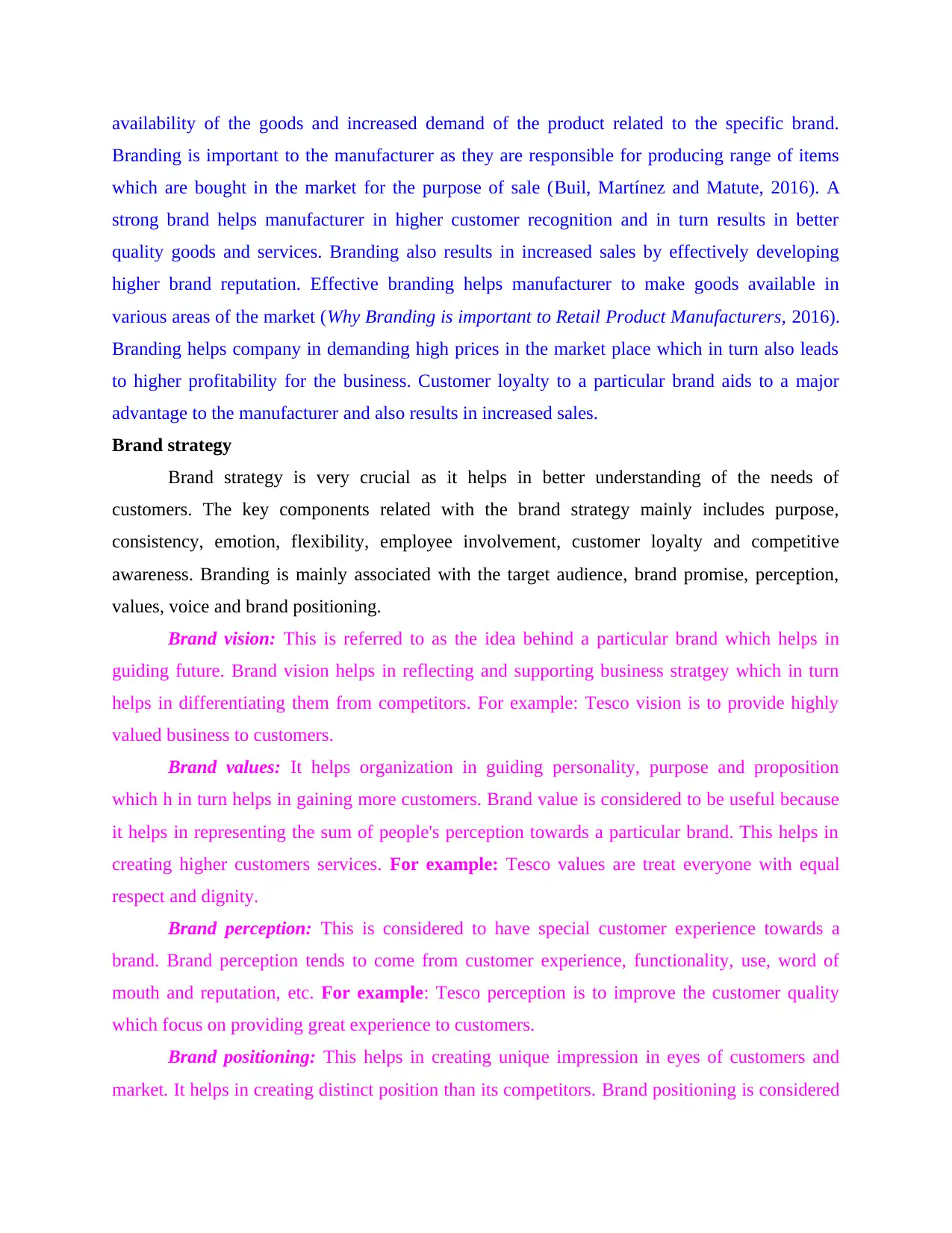
availability of the goods and increased demand of the product related to the specific brand.
Branding is important to the manufacturer as they are responsible for producing range of items
which are bought in the market for the purpose of sale (Buil, Martínez and Matute, 2016). A
strong brand helps manufacturer in higher customer recognition and in turn results in better
quality goods and services. Branding also results in increased sales by effectively developing
higher brand reputation. Effective branding helps manufacturer to make goods available in
various areas of the market (Why Branding is important to Retail Product Manufacturers, 2016).
Branding helps company in demanding high prices in the market place which in turn also leads
to higher profitability for the business. Customer loyalty to a particular brand aids to a major
advantage to the manufacturer and also results in increased sales.
Brand strategy
Brand strategy is very crucial as it helps in better understanding of the needs of
customers. The key components related with the brand strategy mainly includes purpose,
consistency, emotion, flexibility, employee involvement, customer loyalty and competitive
awareness. Branding is mainly associated with the target audience, brand promise, perception,
values, voice and brand positioning.
Brand vision: This is referred to as the idea behind a particular brand which helps in
guiding future. Brand vision helps in reflecting and supporting business stratgey which in turn
helps in differentiating them from competitors. For example: Tesco vision is to provide highly
valued business to customers.
Brand values: It helps organization in guiding personality, purpose and proposition
which h in turn helps in gaining more customers. Brand value is considered to be useful because
it helps in representing the sum of people's perception towards a particular brand. This helps in
creating higher customers services. For example: Tesco values are treat everyone with equal
respect and dignity.
Brand perception: This is considered to have special customer experience towards a
brand. Brand perception tends to come from customer experience, functionality, use, word of
mouth and reputation, etc. For example: Tesco perception is to improve the customer quality
which focus on providing great experience to customers.
Brand positioning: This helps in creating unique impression in eyes of customers and
market. It helps in creating distinct position than its competitors. Brand positioning is considered
Branding is important to the manufacturer as they are responsible for producing range of items
which are bought in the market for the purpose of sale (Buil, Martínez and Matute, 2016). A
strong brand helps manufacturer in higher customer recognition and in turn results in better
quality goods and services. Branding also results in increased sales by effectively developing
higher brand reputation. Effective branding helps manufacturer to make goods available in
various areas of the market (Why Branding is important to Retail Product Manufacturers, 2016).
Branding helps company in demanding high prices in the market place which in turn also leads
to higher profitability for the business. Customer loyalty to a particular brand aids to a major
advantage to the manufacturer and also results in increased sales.
Brand strategy
Brand strategy is very crucial as it helps in better understanding of the needs of
customers. The key components related with the brand strategy mainly includes purpose,
consistency, emotion, flexibility, employee involvement, customer loyalty and competitive
awareness. Branding is mainly associated with the target audience, brand promise, perception,
values, voice and brand positioning.
Brand vision: This is referred to as the idea behind a particular brand which helps in
guiding future. Brand vision helps in reflecting and supporting business stratgey which in turn
helps in differentiating them from competitors. For example: Tesco vision is to provide highly
valued business to customers.
Brand values: It helps organization in guiding personality, purpose and proposition
which h in turn helps in gaining more customers. Brand value is considered to be useful because
it helps in representing the sum of people's perception towards a particular brand. This helps in
creating higher customers services. For example: Tesco values are treat everyone with equal
respect and dignity.
Brand perception: This is considered to have special customer experience towards a
brand. Brand perception tends to come from customer experience, functionality, use, word of
mouth and reputation, etc. For example: Tesco perception is to improve the customer quality
which focus on providing great experience to customers.
Brand positioning: This helps in creating unique impression in eyes of customers and
market. It helps in creating distinct position than its competitors. Brand positioning is considered
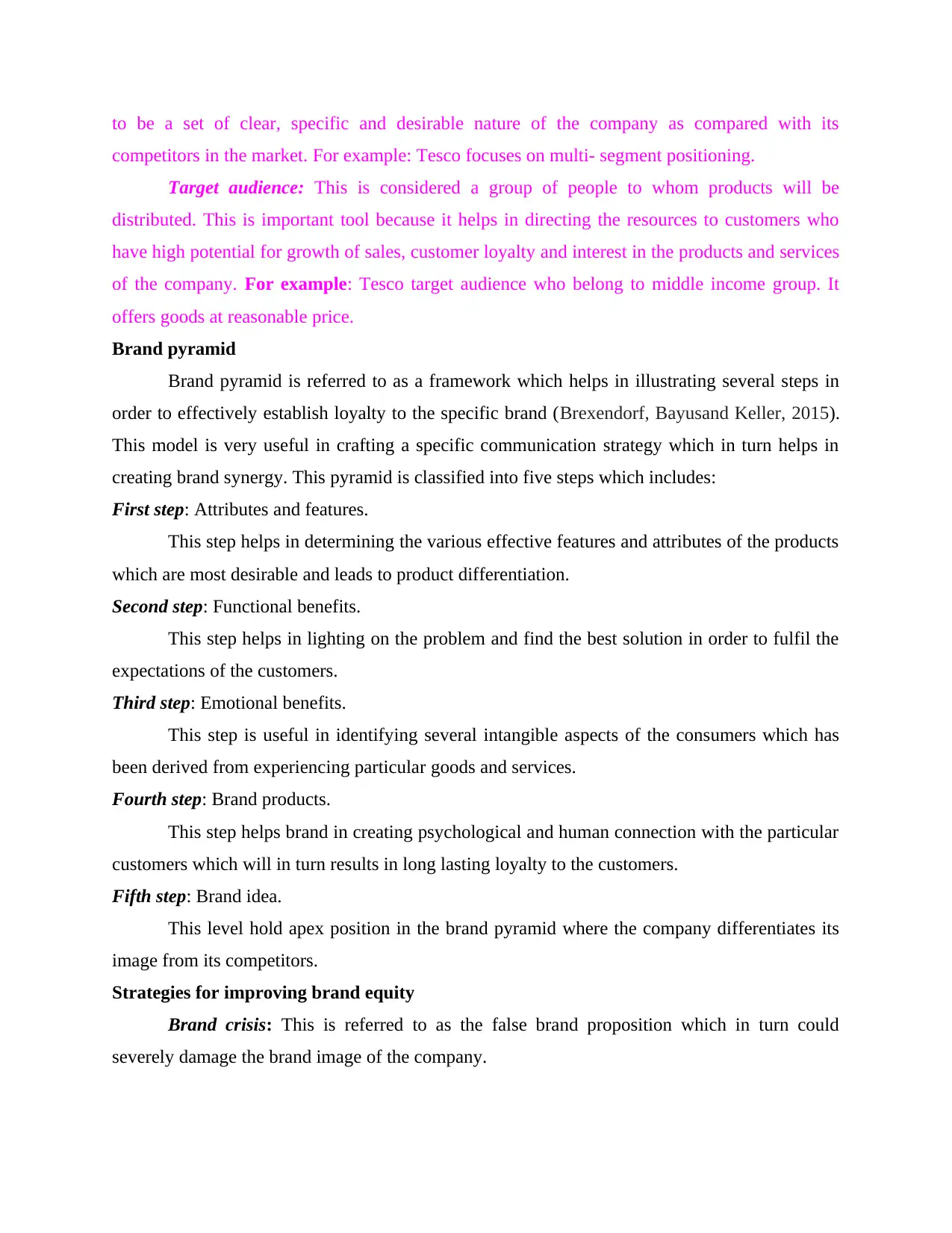
to be a set of clear, specific and desirable nature of the company as compared with its
competitors in the market. For example: Tesco focuses on multi- segment positioning.
Target audience: This is considered a group of people to whom products will be
distributed. This is important tool because it helps in directing the resources to customers who
have high potential for growth of sales, customer loyalty and interest in the products and services
of the company. For example: Tesco target audience who belong to middle income group. It
offers goods at reasonable price.
Brand pyramid
Brand pyramid is referred to as a framework which helps in illustrating several steps in
order to effectively establish loyalty to the specific brand (Brexendorf, Bayusand Keller, 2015).
This model is very useful in crafting a specific communication strategy which in turn helps in
creating brand synergy. This pyramid is classified into five steps which includes:
First step: Attributes and features.
This step helps in determining the various effective features and attributes of the products
which are most desirable and leads to product differentiation.
Second step: Functional benefits.
This step helps in lighting on the problem and find the best solution in order to fulfil the
expectations of the customers.
Third step: Emotional benefits.
This step is useful in identifying several intangible aspects of the consumers which has
been derived from experiencing particular goods and services.
Fourth step: Brand products.
This step helps brand in creating psychological and human connection with the particular
customers which will in turn results in long lasting loyalty to the customers.
Fifth step: Brand idea.
This level hold apex position in the brand pyramid where the company differentiates its
image from its competitors.
Strategies for improving brand equity
Brand crisis: This is referred to as the false brand proposition which in turn could
severely damage the brand image of the company.
competitors in the market. For example: Tesco focuses on multi- segment positioning.
Target audience: This is considered a group of people to whom products will be
distributed. This is important tool because it helps in directing the resources to customers who
have high potential for growth of sales, customer loyalty and interest in the products and services
of the company. For example: Tesco target audience who belong to middle income group. It
offers goods at reasonable price.
Brand pyramid
Brand pyramid is referred to as a framework which helps in illustrating several steps in
order to effectively establish loyalty to the specific brand (Brexendorf, Bayusand Keller, 2015).
This model is very useful in crafting a specific communication strategy which in turn helps in
creating brand synergy. This pyramid is classified into five steps which includes:
First step: Attributes and features.
This step helps in determining the various effective features and attributes of the products
which are most desirable and leads to product differentiation.
Second step: Functional benefits.
This step helps in lighting on the problem and find the best solution in order to fulfil the
expectations of the customers.
Third step: Emotional benefits.
This step is useful in identifying several intangible aspects of the consumers which has
been derived from experiencing particular goods and services.
Fourth step: Brand products.
This step helps brand in creating psychological and human connection with the particular
customers which will in turn results in long lasting loyalty to the customers.
Fifth step: Brand idea.
This level hold apex position in the brand pyramid where the company differentiates its
image from its competitors.
Strategies for improving brand equity
Brand crisis: This is referred to as the false brand proposition which in turn could
severely damage the brand image of the company.
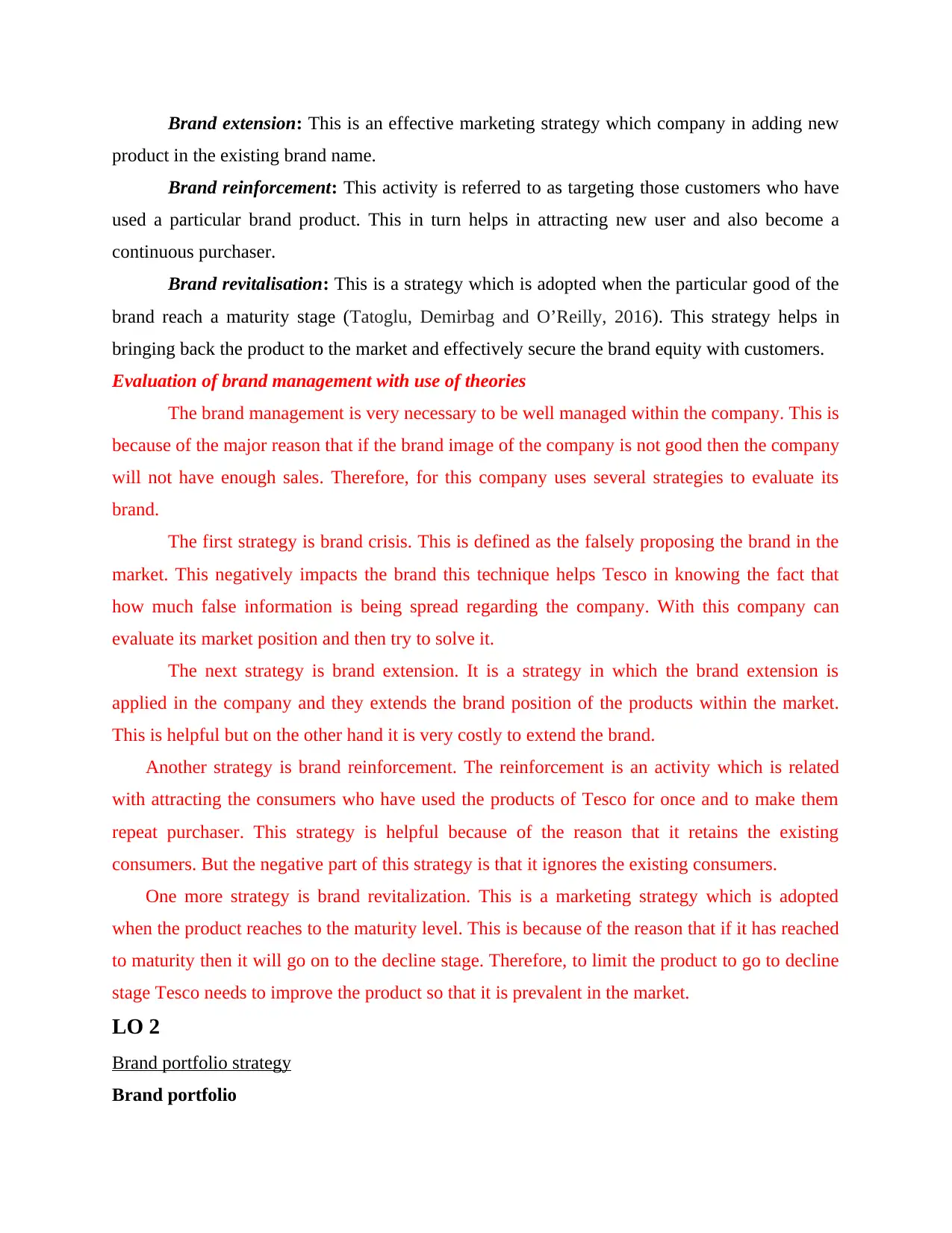
Brand extension: This is an effective marketing strategy which company in adding new
product in the existing brand name.
Brand reinforcement: This activity is referred to as targeting those customers who have
used a particular brand product. This in turn helps in attracting new user and also become a
continuous purchaser.
Brand revitalisation: This is a strategy which is adopted when the particular good of the
brand reach a maturity stage (Tatoglu, Demirbag and O’Reilly, 2016). This strategy helps in
bringing back the product to the market and effectively secure the brand equity with customers.
Evaluation of brand management with use of theories
The brand management is very necessary to be well managed within the company. This is
because of the major reason that if the brand image of the company is not good then the company
will not have enough sales. Therefore, for this company uses several strategies to evaluate its
brand.
The first strategy is brand crisis. This is defined as the falsely proposing the brand in the
market. This negatively impacts the brand this technique helps Tesco in knowing the fact that
how much false information is being spread regarding the company. With this company can
evaluate its market position and then try to solve it.
The next strategy is brand extension. It is a strategy in which the brand extension is
applied in the company and they extends the brand position of the products within the market.
This is helpful but on the other hand it is very costly to extend the brand.
Another strategy is brand reinforcement. The reinforcement is an activity which is related
with attracting the consumers who have used the products of Tesco for once and to make them
repeat purchaser. This strategy is helpful because of the reason that it retains the existing
consumers. But the negative part of this strategy is that it ignores the existing consumers.
One more strategy is brand revitalization. This is a marketing strategy which is adopted
when the product reaches to the maturity level. This is because of the reason that if it has reached
to maturity then it will go on to the decline stage. Therefore, to limit the product to go to decline
stage Tesco needs to improve the product so that it is prevalent in the market.
LO 2
Brand portfolio strategy
Brand portfolio
product in the existing brand name.
Brand reinforcement: This activity is referred to as targeting those customers who have
used a particular brand product. This in turn helps in attracting new user and also become a
continuous purchaser.
Brand revitalisation: This is a strategy which is adopted when the particular good of the
brand reach a maturity stage (Tatoglu, Demirbag and O’Reilly, 2016). This strategy helps in
bringing back the product to the market and effectively secure the brand equity with customers.
Evaluation of brand management with use of theories
The brand management is very necessary to be well managed within the company. This is
because of the major reason that if the brand image of the company is not good then the company
will not have enough sales. Therefore, for this company uses several strategies to evaluate its
brand.
The first strategy is brand crisis. This is defined as the falsely proposing the brand in the
market. This negatively impacts the brand this technique helps Tesco in knowing the fact that
how much false information is being spread regarding the company. With this company can
evaluate its market position and then try to solve it.
The next strategy is brand extension. It is a strategy in which the brand extension is
applied in the company and they extends the brand position of the products within the market.
This is helpful but on the other hand it is very costly to extend the brand.
Another strategy is brand reinforcement. The reinforcement is an activity which is related
with attracting the consumers who have used the products of Tesco for once and to make them
repeat purchaser. This strategy is helpful because of the reason that it retains the existing
consumers. But the negative part of this strategy is that it ignores the existing consumers.
One more strategy is brand revitalization. This is a marketing strategy which is adopted
when the product reaches to the maturity level. This is because of the reason that if it has reached
to maturity then it will go on to the decline stage. Therefore, to limit the product to go to decline
stage Tesco needs to improve the product so that it is prevalent in the market.
LO 2
Brand portfolio strategy
Brand portfolio
Paraphrase This Document
Need a fresh take? Get an instant paraphrase of this document with our AI Paraphraser
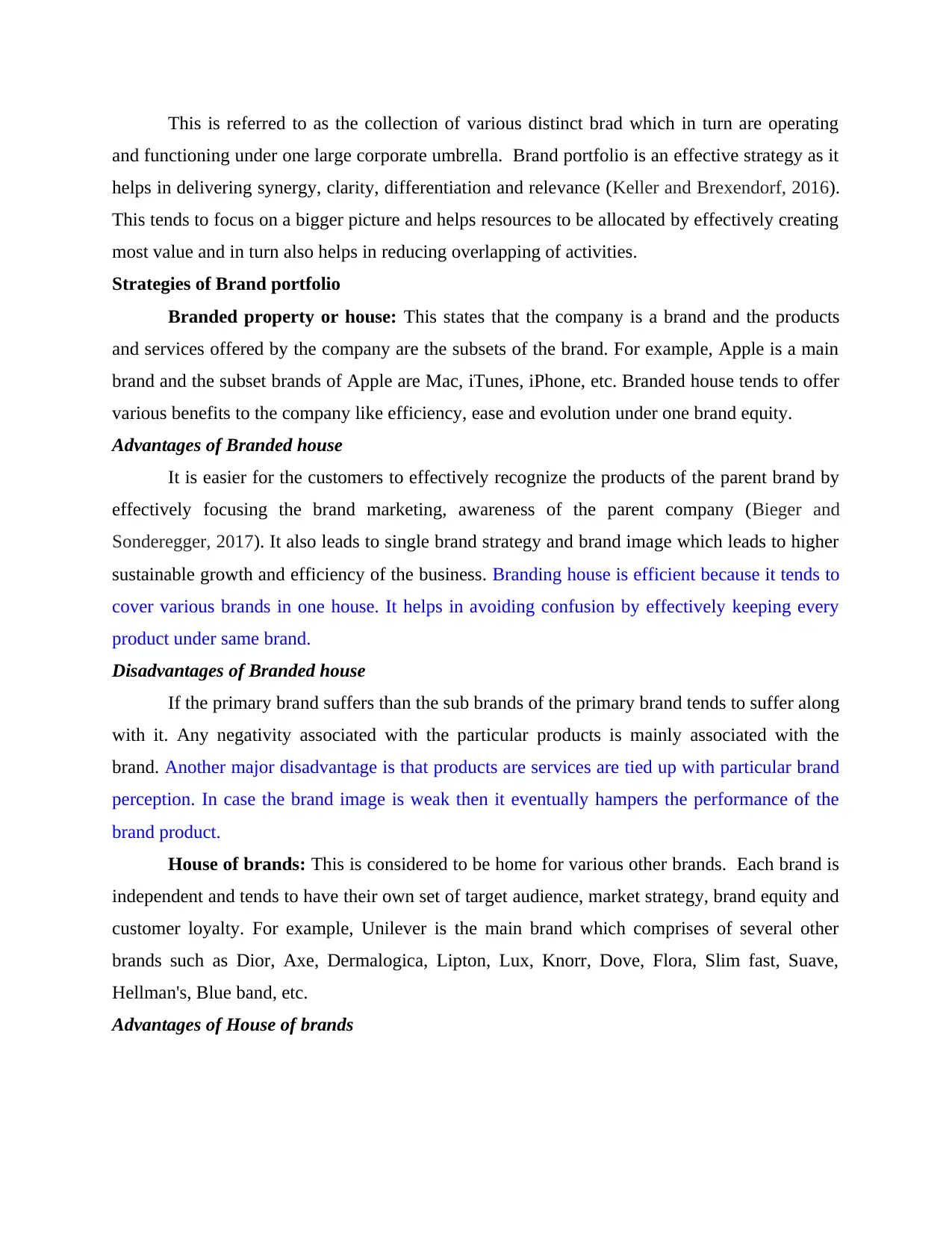
This is referred to as the collection of various distinct brad which in turn are operating
and functioning under one large corporate umbrella. Brand portfolio is an effective strategy as it
helps in delivering synergy, clarity, differentiation and relevance (Keller and Brexendorf, 2016).
This tends to focus on a bigger picture and helps resources to be allocated by effectively creating
most value and in turn also helps in reducing overlapping of activities.
Strategies of Brand portfolio
Branded property or house: This states that the company is a brand and the products
and services offered by the company are the subsets of the brand. For example, Apple is a main
brand and the subset brands of Apple are Mac, iTunes, iPhone, etc. Branded house tends to offer
various benefits to the company like efficiency, ease and evolution under one brand equity.
Advantages of Branded house
It is easier for the customers to effectively recognize the products of the parent brand by
effectively focusing the brand marketing, awareness of the parent company (Bieger and
Sonderegger, 2017). It also leads to single brand strategy and brand image which leads to higher
sustainable growth and efficiency of the business. Branding house is efficient because it tends to
cover various brands in one house. It helps in avoiding confusion by effectively keeping every
product under same brand.
Disadvantages of Branded house
If the primary brand suffers than the sub brands of the primary brand tends to suffer along
with it. Any negativity associated with the particular products is mainly associated with the
brand. Another major disadvantage is that products are services are tied up with particular brand
perception. In case the brand image is weak then it eventually hampers the performance of the
brand product.
House of brands: This is considered to be home for various other brands. Each brand is
independent and tends to have their own set of target audience, market strategy, brand equity and
customer loyalty. For example, Unilever is the main brand which comprises of several other
brands such as Dior, Axe, Dermalogica, Lipton, Lux, Knorr, Dove, Flora, Slim fast, Suave,
Hellman's, Blue band, etc.
Advantages of House of brands
and functioning under one large corporate umbrella. Brand portfolio is an effective strategy as it
helps in delivering synergy, clarity, differentiation and relevance (Keller and Brexendorf, 2016).
This tends to focus on a bigger picture and helps resources to be allocated by effectively creating
most value and in turn also helps in reducing overlapping of activities.
Strategies of Brand portfolio
Branded property or house: This states that the company is a brand and the products
and services offered by the company are the subsets of the brand. For example, Apple is a main
brand and the subset brands of Apple are Mac, iTunes, iPhone, etc. Branded house tends to offer
various benefits to the company like efficiency, ease and evolution under one brand equity.
Advantages of Branded house
It is easier for the customers to effectively recognize the products of the parent brand by
effectively focusing the brand marketing, awareness of the parent company (Bieger and
Sonderegger, 2017). It also leads to single brand strategy and brand image which leads to higher
sustainable growth and efficiency of the business. Branding house is efficient because it tends to
cover various brands in one house. It helps in avoiding confusion by effectively keeping every
product under same brand.
Disadvantages of Branded house
If the primary brand suffers than the sub brands of the primary brand tends to suffer along
with it. Any negativity associated with the particular products is mainly associated with the
brand. Another major disadvantage is that products are services are tied up with particular brand
perception. In case the brand image is weak then it eventually hampers the performance of the
brand product.
House of brands: This is considered to be home for various other brands. Each brand is
independent and tends to have their own set of target audience, market strategy, brand equity and
customer loyalty. For example, Unilever is the main brand which comprises of several other
brands such as Dior, Axe, Dermalogica, Lipton, Lux, Knorr, Dove, Flora, Slim fast, Suave,
Hellman's, Blue band, etc.
Advantages of House of brands
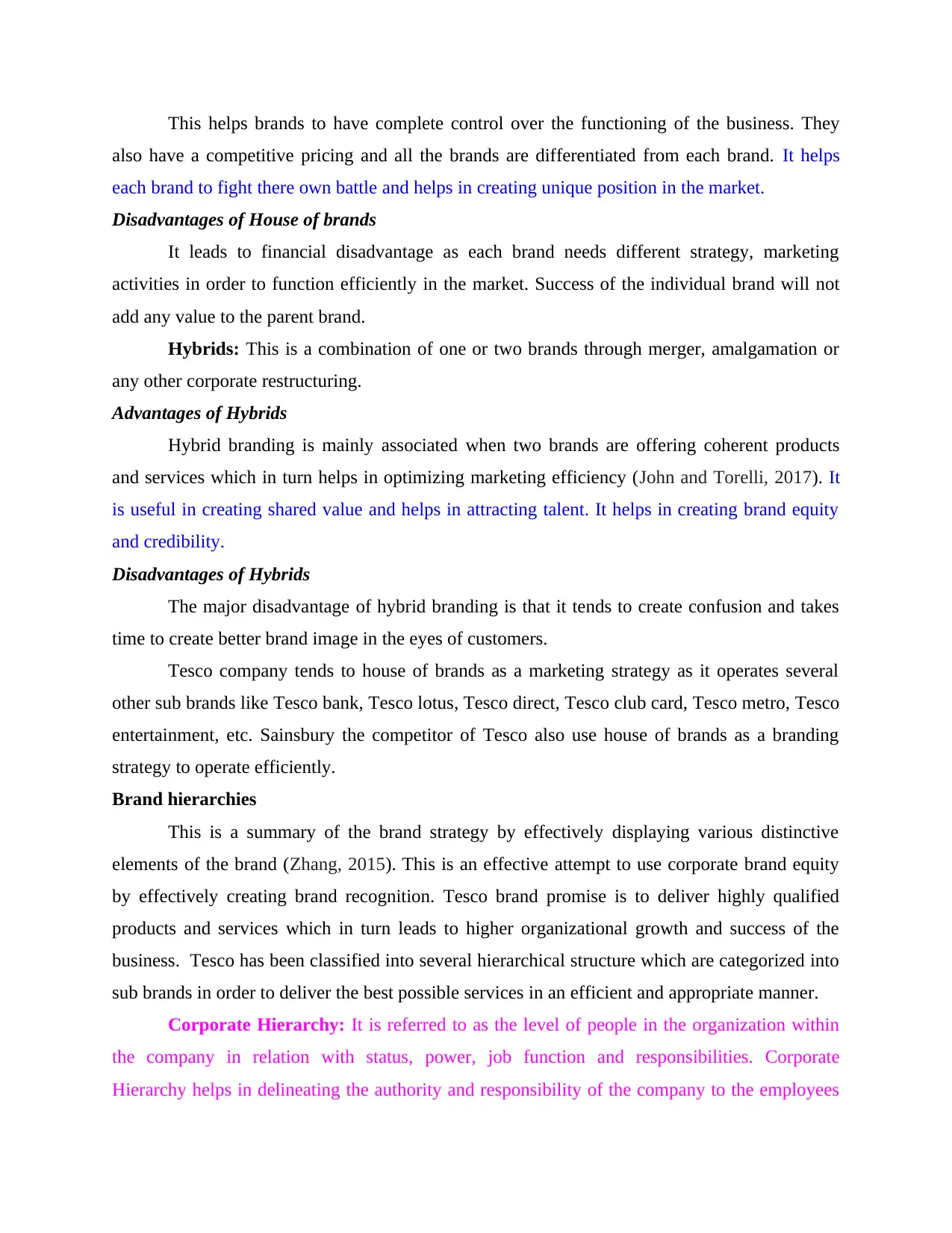
This helps brands to have complete control over the functioning of the business. They
also have a competitive pricing and all the brands are differentiated from each brand. It helps
each brand to fight there own battle and helps in creating unique position in the market.
Disadvantages of House of brands
It leads to financial disadvantage as each brand needs different strategy, marketing
activities in order to function efficiently in the market. Success of the individual brand will not
add any value to the parent brand.
Hybrids: This is a combination of one or two brands through merger, amalgamation or
any other corporate restructuring.
Advantages of Hybrids
Hybrid branding is mainly associated when two brands are offering coherent products
and services which in turn helps in optimizing marketing efficiency (John and Torelli, 2017). It
is useful in creating shared value and helps in attracting talent. It helps in creating brand equity
and credibility.
Disadvantages of Hybrids
The major disadvantage of hybrid branding is that it tends to create confusion and takes
time to create better brand image in the eyes of customers.
Tesco company tends to house of brands as a marketing strategy as it operates several
other sub brands like Tesco bank, Tesco lotus, Tesco direct, Tesco club card, Tesco metro, Tesco
entertainment, etc. Sainsbury the competitor of Tesco also use house of brands as a branding
strategy to operate efficiently.
Brand hierarchies
This is a summary of the brand strategy by effectively displaying various distinctive
elements of the brand (Zhang, 2015). This is an effective attempt to use corporate brand equity
by effectively creating brand recognition. Tesco brand promise is to deliver highly qualified
products and services which in turn leads to higher organizational growth and success of the
business. Tesco has been classified into several hierarchical structure which are categorized into
sub brands in order to deliver the best possible services in an efficient and appropriate manner.
Corporate Hierarchy: It is referred to as the level of people in the organization within
the company in relation with status, power, job function and responsibilities. Corporate
Hierarchy helps in delineating the authority and responsibility of the company to the employees
also have a competitive pricing and all the brands are differentiated from each brand. It helps
each brand to fight there own battle and helps in creating unique position in the market.
Disadvantages of House of brands
It leads to financial disadvantage as each brand needs different strategy, marketing
activities in order to function efficiently in the market. Success of the individual brand will not
add any value to the parent brand.
Hybrids: This is a combination of one or two brands through merger, amalgamation or
any other corporate restructuring.
Advantages of Hybrids
Hybrid branding is mainly associated when two brands are offering coherent products
and services which in turn helps in optimizing marketing efficiency (John and Torelli, 2017). It
is useful in creating shared value and helps in attracting talent. It helps in creating brand equity
and credibility.
Disadvantages of Hybrids
The major disadvantage of hybrid branding is that it tends to create confusion and takes
time to create better brand image in the eyes of customers.
Tesco company tends to house of brands as a marketing strategy as it operates several
other sub brands like Tesco bank, Tesco lotus, Tesco direct, Tesco club card, Tesco metro, Tesco
entertainment, etc. Sainsbury the competitor of Tesco also use house of brands as a branding
strategy to operate efficiently.
Brand hierarchies
This is a summary of the brand strategy by effectively displaying various distinctive
elements of the brand (Zhang, 2015). This is an effective attempt to use corporate brand equity
by effectively creating brand recognition. Tesco brand promise is to deliver highly qualified
products and services which in turn leads to higher organizational growth and success of the
business. Tesco has been classified into several hierarchical structure which are categorized into
sub brands in order to deliver the best possible services in an efficient and appropriate manner.
Corporate Hierarchy: It is referred to as the level of people in the organization within
the company in relation with status, power, job function and responsibilities. Corporate
Hierarchy helps in delineating the authority and responsibility of the company to the employees
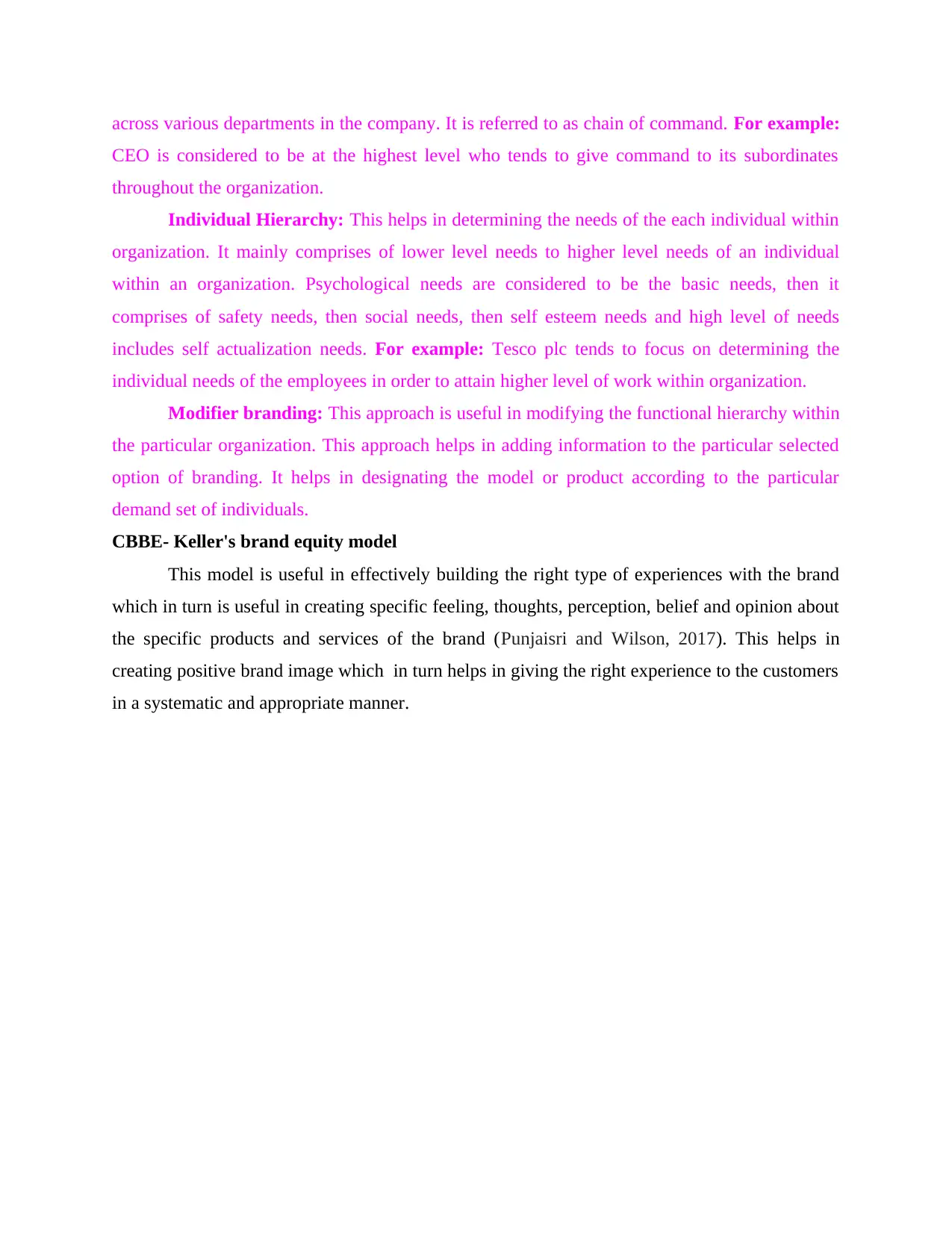
across various departments in the company. It is referred to as chain of command. For example:
CEO is considered to be at the highest level who tends to give command to its subordinates
throughout the organization.
Individual Hierarchy: This helps in determining the needs of the each individual within
organization. It mainly comprises of lower level needs to higher level needs of an individual
within an organization. Psychological needs are considered to be the basic needs, then it
comprises of safety needs, then social needs, then self esteem needs and high level of needs
includes self actualization needs. For example: Tesco plc tends to focus on determining the
individual needs of the employees in order to attain higher level of work within organization.
Modifier branding: This approach is useful in modifying the functional hierarchy within
the particular organization. This approach helps in adding information to the particular selected
option of branding. It helps in designating the model or product according to the particular
demand set of individuals.
CBBE- Keller's brand equity model
This model is useful in effectively building the right type of experiences with the brand
which in turn is useful in creating specific feeling, thoughts, perception, belief and opinion about
the specific products and services of the brand (Punjaisri and Wilson, 2017). This helps in
creating positive brand image which in turn helps in giving the right experience to the customers
in a systematic and appropriate manner.
CEO is considered to be at the highest level who tends to give command to its subordinates
throughout the organization.
Individual Hierarchy: This helps in determining the needs of the each individual within
organization. It mainly comprises of lower level needs to higher level needs of an individual
within an organization. Psychological needs are considered to be the basic needs, then it
comprises of safety needs, then social needs, then self esteem needs and high level of needs
includes self actualization needs. For example: Tesco plc tends to focus on determining the
individual needs of the employees in order to attain higher level of work within organization.
Modifier branding: This approach is useful in modifying the functional hierarchy within
the particular organization. This approach helps in adding information to the particular selected
option of branding. It helps in designating the model or product according to the particular
demand set of individuals.
CBBE- Keller's brand equity model
This model is useful in effectively building the right type of experiences with the brand
which in turn is useful in creating specific feeling, thoughts, perception, belief and opinion about
the specific products and services of the brand (Punjaisri and Wilson, 2017). This helps in
creating positive brand image which in turn helps in giving the right experience to the customers
in a systematic and appropriate manner.
Secure Best Marks with AI Grader
Need help grading? Try our AI Grader for instant feedback on your assignments.
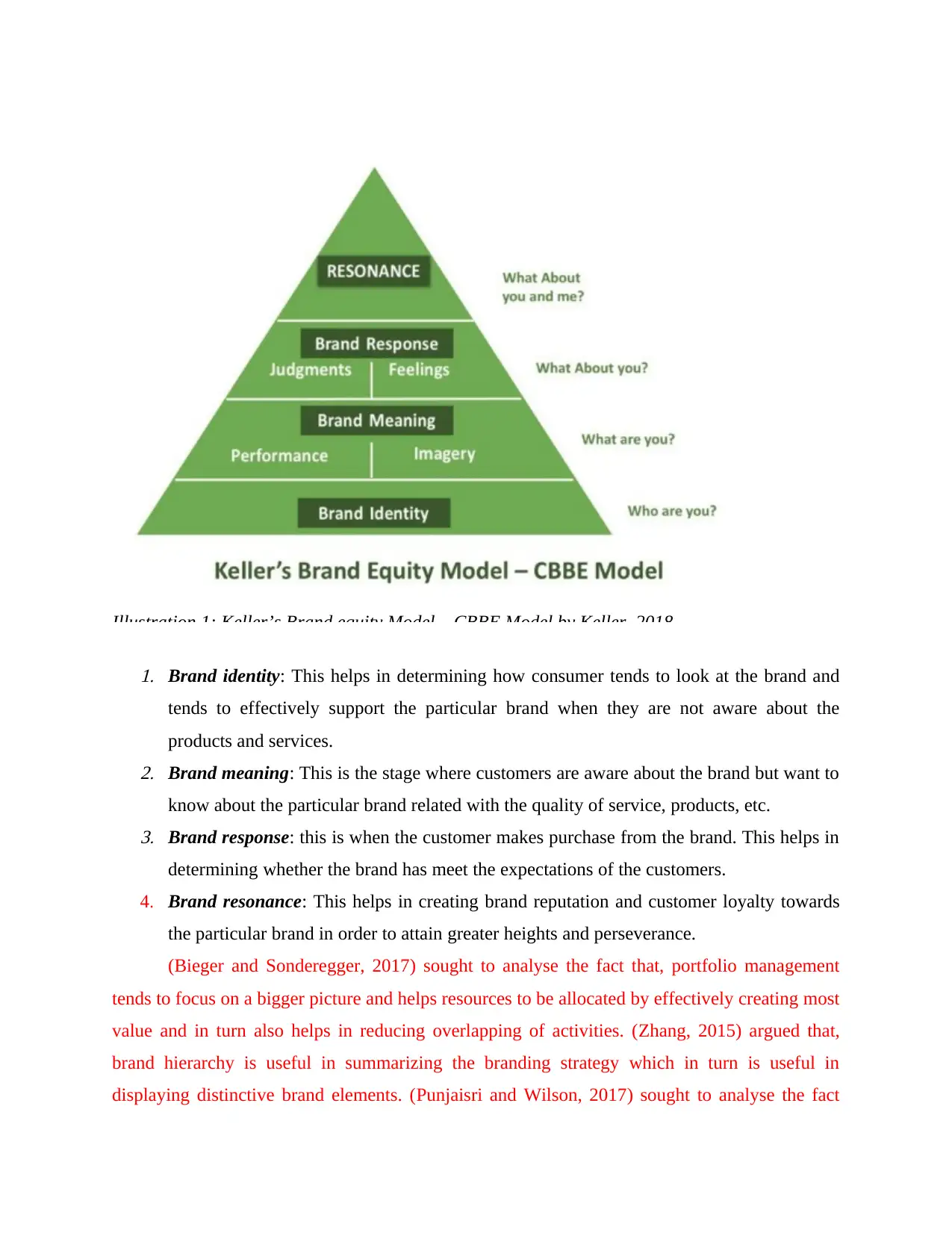
Illustration 1: Keller’s Brand equity Model – CBBE Model by Keller, 2018
1. Brand identity: This helps in determining how consumer tends to look at the brand and
tends to effectively support the particular brand when they are not aware about the
products and services.2. Brand meaning: This is the stage where customers are aware about the brand but want to
know about the particular brand related with the quality of service, products, etc.3. Brand response: this is when the customer makes purchase from the brand. This helps in
determining whether the brand has meet the expectations of the customers.
4. Brand resonance: This helps in creating brand reputation and customer loyalty towards
the particular brand in order to attain greater heights and perseverance.
(Bieger and Sonderegger, 2017) sought to analyse the fact that, portfolio management
tends to focus on a bigger picture and helps resources to be allocated by effectively creating most
value and in turn also helps in reducing overlapping of activities. (Zhang, 2015) argued that,
brand hierarchy is useful in summarizing the branding strategy which in turn is useful in
displaying distinctive brand elements. (Punjaisri and Wilson, 2017) sought to analyse the fact
1. Brand identity: This helps in determining how consumer tends to look at the brand and
tends to effectively support the particular brand when they are not aware about the
products and services.2. Brand meaning: This is the stage where customers are aware about the brand but want to
know about the particular brand related with the quality of service, products, etc.3. Brand response: this is when the customer makes purchase from the brand. This helps in
determining whether the brand has meet the expectations of the customers.
4. Brand resonance: This helps in creating brand reputation and customer loyalty towards
the particular brand in order to attain greater heights and perseverance.
(Bieger and Sonderegger, 2017) sought to analyse the fact that, portfolio management
tends to focus on a bigger picture and helps resources to be allocated by effectively creating most
value and in turn also helps in reducing overlapping of activities. (Zhang, 2015) argued that,
brand hierarchy is useful in summarizing the branding strategy which in turn is useful in
displaying distinctive brand elements. (Punjaisri and Wilson, 2017) sought to analyse the fact
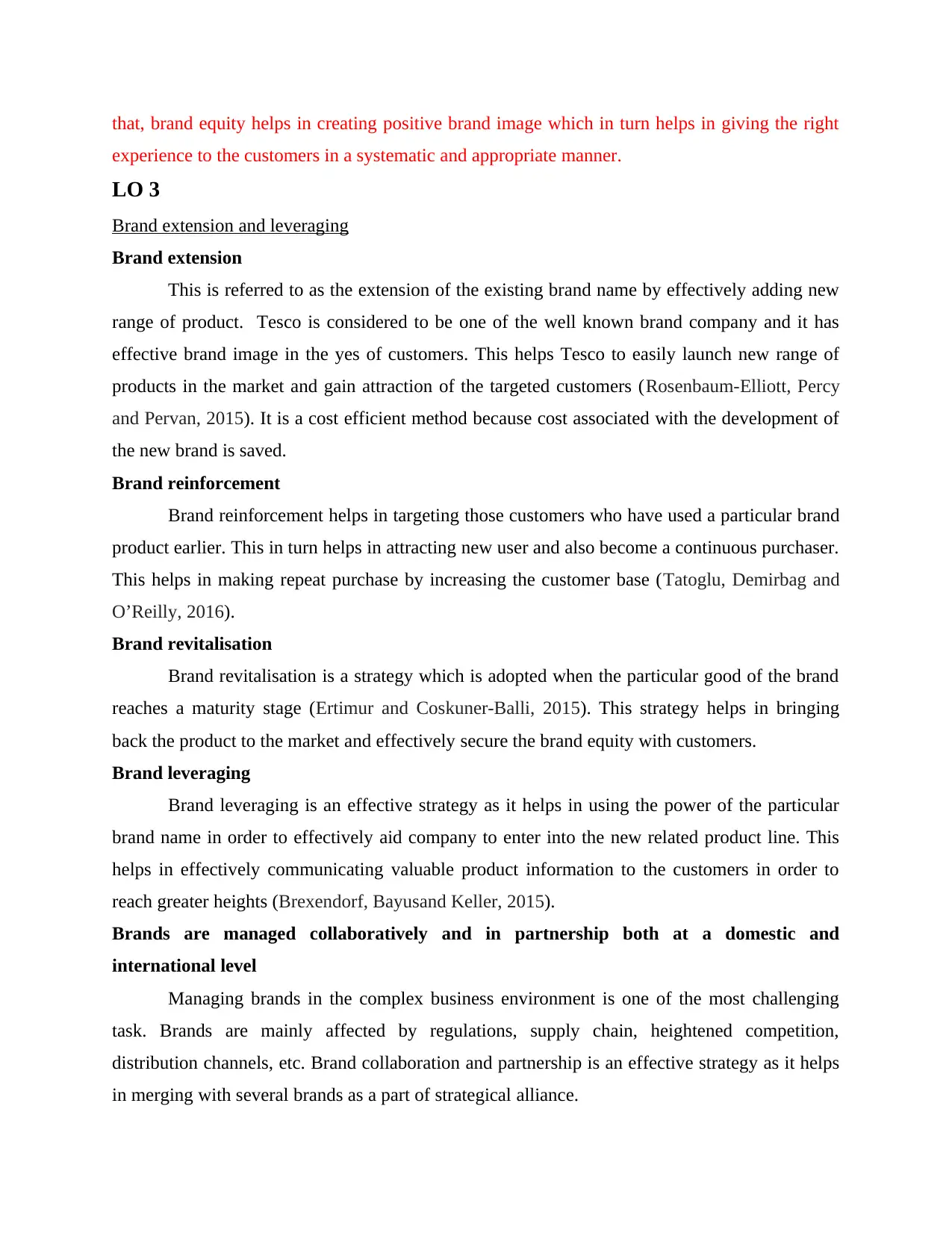
that, brand equity helps in creating positive brand image which in turn helps in giving the right
experience to the customers in a systematic and appropriate manner.
LO 3
Brand extension and leveraging
Brand extension
This is referred to as the extension of the existing brand name by effectively adding new
range of product. Tesco is considered to be one of the well known brand company and it has
effective brand image in the yes of customers. This helps Tesco to easily launch new range of
products in the market and gain attraction of the targeted customers (Rosenbaum-Elliott, Percy
and Pervan, 2015). It is a cost efficient method because cost associated with the development of
the new brand is saved.
Brand reinforcement
Brand reinforcement helps in targeting those customers who have used a particular brand
product earlier. This in turn helps in attracting new user and also become a continuous purchaser.
This helps in making repeat purchase by increasing the customer base (Tatoglu, Demirbag and
O’Reilly, 2016).
Brand revitalisation
Brand revitalisation is a strategy which is adopted when the particular good of the brand
reaches a maturity stage (Ertimur and Coskuner-Balli, 2015). This strategy helps in bringing
back the product to the market and effectively secure the brand equity with customers.
Brand leveraging
Brand leveraging is an effective strategy as it helps in using the power of the particular
brand name in order to effectively aid company to enter into the new related product line. This
helps in effectively communicating valuable product information to the customers in order to
reach greater heights (Brexendorf, Bayusand Keller, 2015).
Brands are managed collaboratively and in partnership both at a domestic and
international level
Managing brands in the complex business environment is one of the most challenging
task. Brands are mainly affected by regulations, supply chain, heightened competition,
distribution channels, etc. Brand collaboration and partnership is an effective strategy as it helps
in merging with several brands as a part of strategical alliance.
experience to the customers in a systematic and appropriate manner.
LO 3
Brand extension and leveraging
Brand extension
This is referred to as the extension of the existing brand name by effectively adding new
range of product. Tesco is considered to be one of the well known brand company and it has
effective brand image in the yes of customers. This helps Tesco to easily launch new range of
products in the market and gain attraction of the targeted customers (Rosenbaum-Elliott, Percy
and Pervan, 2015). It is a cost efficient method because cost associated with the development of
the new brand is saved.
Brand reinforcement
Brand reinforcement helps in targeting those customers who have used a particular brand
product earlier. This in turn helps in attracting new user and also become a continuous purchaser.
This helps in making repeat purchase by increasing the customer base (Tatoglu, Demirbag and
O’Reilly, 2016).
Brand revitalisation
Brand revitalisation is a strategy which is adopted when the particular good of the brand
reaches a maturity stage (Ertimur and Coskuner-Balli, 2015). This strategy helps in bringing
back the product to the market and effectively secure the brand equity with customers.
Brand leveraging
Brand leveraging is an effective strategy as it helps in using the power of the particular
brand name in order to effectively aid company to enter into the new related product line. This
helps in effectively communicating valuable product information to the customers in order to
reach greater heights (Brexendorf, Bayusand Keller, 2015).
Brands are managed collaboratively and in partnership both at a domestic and
international level
Managing brands in the complex business environment is one of the most challenging
task. Brands are mainly affected by regulations, supply chain, heightened competition,
distribution channels, etc. Brand collaboration and partnership is an effective strategy as it helps
in merging with several brands as a part of strategical alliance.
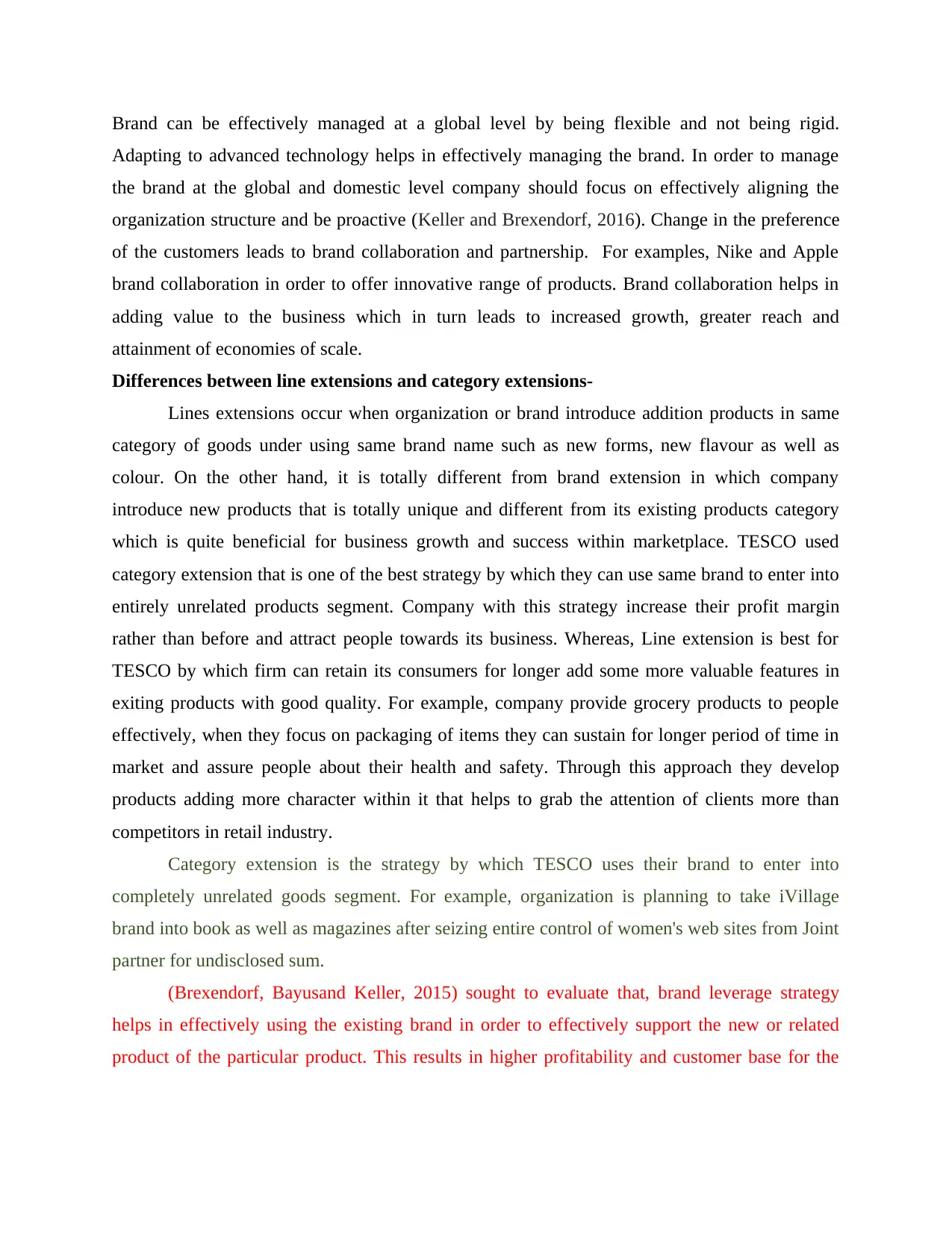
Brand can be effectively managed at a global level by being flexible and not being rigid.
Adapting to advanced technology helps in effectively managing the brand. In order to manage
the brand at the global and domestic level company should focus on effectively aligning the
organization structure and be proactive (Keller and Brexendorf, 2016). Change in the preference
of the customers leads to brand collaboration and partnership. For examples, Nike and Apple
brand collaboration in order to offer innovative range of products. Brand collaboration helps in
adding value to the business which in turn leads to increased growth, greater reach and
attainment of economies of scale.
Differences between line extensions and category extensions-
Lines extensions occur when organization or brand introduce addition products in same
category of goods under using same brand name such as new forms, new flavour as well as
colour. On the other hand, it is totally different from brand extension in which company
introduce new products that is totally unique and different from its existing products category
which is quite beneficial for business growth and success within marketplace. TESCO used
category extension that is one of the best strategy by which they can use same brand to enter into
entirely unrelated products segment. Company with this strategy increase their profit margin
rather than before and attract people towards its business. Whereas, Line extension is best for
TESCO by which firm can retain its consumers for longer add some more valuable features in
exiting products with good quality. For example, company provide grocery products to people
effectively, when they focus on packaging of items they can sustain for longer period of time in
market and assure people about their health and safety. Through this approach they develop
products adding more character within it that helps to grab the attention of clients more than
competitors in retail industry.
Category extension is the strategy by which TESCO uses their brand to enter into
completely unrelated goods segment. For example, organization is planning to take iVillage
brand into book as well as magazines after seizing entire control of women's web sites from Joint
partner for undisclosed sum.
(Brexendorf, Bayusand Keller, 2015) sought to evaluate that, brand leverage strategy
helps in effectively using the existing brand in order to effectively support the new or related
product of the particular product. This results in higher profitability and customer base for the
Adapting to advanced technology helps in effectively managing the brand. In order to manage
the brand at the global and domestic level company should focus on effectively aligning the
organization structure and be proactive (Keller and Brexendorf, 2016). Change in the preference
of the customers leads to brand collaboration and partnership. For examples, Nike and Apple
brand collaboration in order to offer innovative range of products. Brand collaboration helps in
adding value to the business which in turn leads to increased growth, greater reach and
attainment of economies of scale.
Differences between line extensions and category extensions-
Lines extensions occur when organization or brand introduce addition products in same
category of goods under using same brand name such as new forms, new flavour as well as
colour. On the other hand, it is totally different from brand extension in which company
introduce new products that is totally unique and different from its existing products category
which is quite beneficial for business growth and success within marketplace. TESCO used
category extension that is one of the best strategy by which they can use same brand to enter into
entirely unrelated products segment. Company with this strategy increase their profit margin
rather than before and attract people towards its business. Whereas, Line extension is best for
TESCO by which firm can retain its consumers for longer add some more valuable features in
exiting products with good quality. For example, company provide grocery products to people
effectively, when they focus on packaging of items they can sustain for longer period of time in
market and assure people about their health and safety. Through this approach they develop
products adding more character within it that helps to grab the attention of clients more than
competitors in retail industry.
Category extension is the strategy by which TESCO uses their brand to enter into
completely unrelated goods segment. For example, organization is planning to take iVillage
brand into book as well as magazines after seizing entire control of women's web sites from Joint
partner for undisclosed sum.
(Brexendorf, Bayusand Keller, 2015) sought to evaluate that, brand leverage strategy
helps in effectively using the existing brand in order to effectively support the new or related
product of the particular product. This results in higher profitability and customer base for the
Paraphrase This Document
Need a fresh take? Get an instant paraphrase of this document with our AI Paraphraser
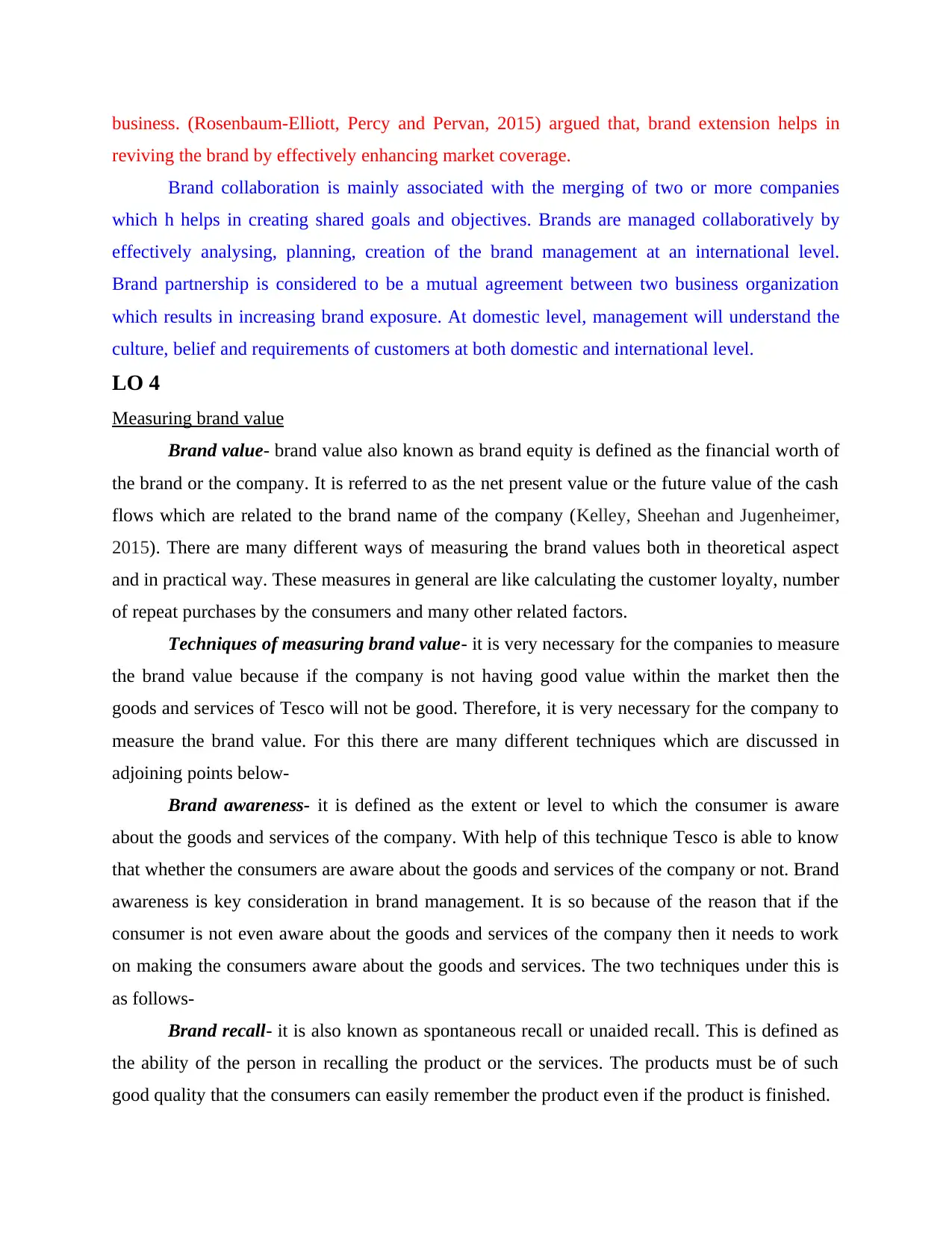
business. (Rosenbaum-Elliott, Percy and Pervan, 2015) argued that, brand extension helps in
reviving the brand by effectively enhancing market coverage.
Brand collaboration is mainly associated with the merging of two or more companies
which h helps in creating shared goals and objectives. Brands are managed collaboratively by
effectively analysing, planning, creation of the brand management at an international level.
Brand partnership is considered to be a mutual agreement between two business organization
which results in increasing brand exposure. At domestic level, management will understand the
culture, belief and requirements of customers at both domestic and international level.
LO 4
Measuring brand value
Brand value- brand value also known as brand equity is defined as the financial worth of
the brand or the company. It is referred to as the net present value or the future value of the cash
flows which are related to the brand name of the company (Kelley, Sheehan and Jugenheimer,
2015). There are many different ways of measuring the brand values both in theoretical aspect
and in practical way. These measures in general are like calculating the customer loyalty, number
of repeat purchases by the consumers and many other related factors.
Techniques of measuring brand value- it is very necessary for the companies to measure
the brand value because if the company is not having good value within the market then the
goods and services of Tesco will not be good. Therefore, it is very necessary for the company to
measure the brand value. For this there are many different techniques which are discussed in
adjoining points below-
Brand awareness- it is defined as the extent or level to which the consumer is aware
about the goods and services of the company. With help of this technique Tesco is able to know
that whether the consumers are aware about the goods and services of the company or not. Brand
awareness is key consideration in brand management. It is so because of the reason that if the
consumer is not even aware about the goods and services of the company then it needs to work
on making the consumers aware about the goods and services. The two techniques under this is
as follows-
Brand recall- it is also known as spontaneous recall or unaided recall. This is defined as
the ability of the person in recalling the product or the services. The products must be of such
good quality that the consumers can easily remember the product even if the product is finished.
reviving the brand by effectively enhancing market coverage.
Brand collaboration is mainly associated with the merging of two or more companies
which h helps in creating shared goals and objectives. Brands are managed collaboratively by
effectively analysing, planning, creation of the brand management at an international level.
Brand partnership is considered to be a mutual agreement between two business organization
which results in increasing brand exposure. At domestic level, management will understand the
culture, belief and requirements of customers at both domestic and international level.
LO 4
Measuring brand value
Brand value- brand value also known as brand equity is defined as the financial worth of
the brand or the company. It is referred to as the net present value or the future value of the cash
flows which are related to the brand name of the company (Kelley, Sheehan and Jugenheimer,
2015). There are many different ways of measuring the brand values both in theoretical aspect
and in practical way. These measures in general are like calculating the customer loyalty, number
of repeat purchases by the consumers and many other related factors.
Techniques of measuring brand value- it is very necessary for the companies to measure
the brand value because if the company is not having good value within the market then the
goods and services of Tesco will not be good. Therefore, it is very necessary for the company to
measure the brand value. For this there are many different techniques which are discussed in
adjoining points below-
Brand awareness- it is defined as the extent or level to which the consumer is aware
about the goods and services of the company. With help of this technique Tesco is able to know
that whether the consumers are aware about the goods and services of the company or not. Brand
awareness is key consideration in brand management. It is so because of the reason that if the
consumer is not even aware about the goods and services of the company then it needs to work
on making the consumers aware about the goods and services. The two techniques under this is
as follows-
Brand recall- it is also known as spontaneous recall or unaided recall. This is defined as
the ability of the person in recalling the product or the services. The products must be of such
good quality that the consumers can easily remember the product even if the product is finished.
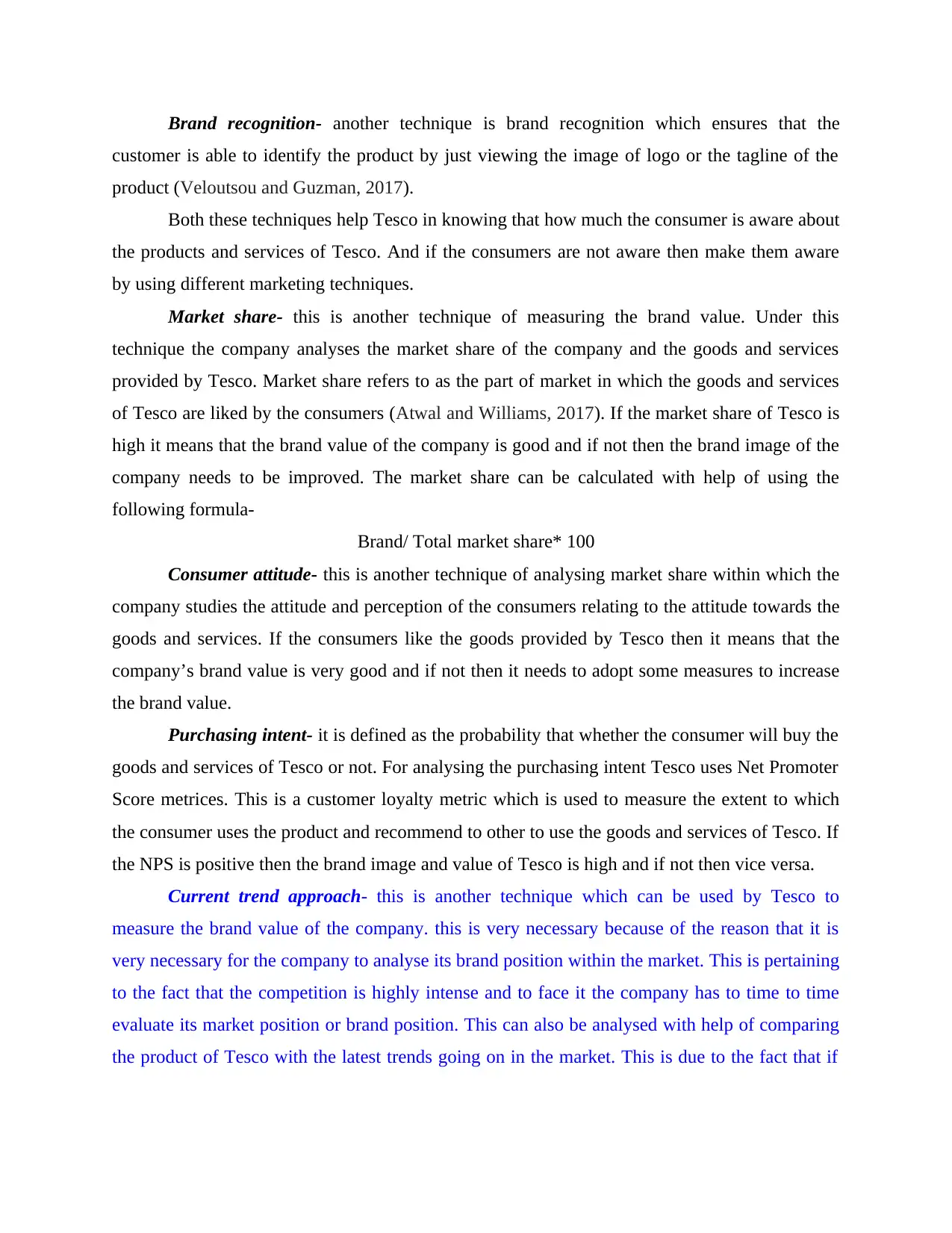
Brand recognition- another technique is brand recognition which ensures that the
customer is able to identify the product by just viewing the image of logo or the tagline of the
product (Veloutsou and Guzman, 2017).
Both these techniques help Tesco in knowing that how much the consumer is aware about
the products and services of Tesco. And if the consumers are not aware then make them aware
by using different marketing techniques.
Market share- this is another technique of measuring the brand value. Under this
technique the company analyses the market share of the company and the goods and services
provided by Tesco. Market share refers to as the part of market in which the goods and services
of Tesco are liked by the consumers (Atwal and Williams, 2017). If the market share of Tesco is
high it means that the brand value of the company is good and if not then the brand image of the
company needs to be improved. The market share can be calculated with help of using the
following formula-
Brand/ Total market share* 100
Consumer attitude- this is another technique of analysing market share within which the
company studies the attitude and perception of the consumers relating to the attitude towards the
goods and services. If the consumers like the goods provided by Tesco then it means that the
company’s brand value is very good and if not then it needs to adopt some measures to increase
the brand value.
Purchasing intent- it is defined as the probability that whether the consumer will buy the
goods and services of Tesco or not. For analysing the purchasing intent Tesco uses Net Promoter
Score metrices. This is a customer loyalty metric which is used to measure the extent to which
the consumer uses the product and recommend to other to use the goods and services of Tesco. If
the NPS is positive then the brand image and value of Tesco is high and if not then vice versa.
Current trend approach- this is another technique which can be used by Tesco to
measure the brand value of the company. this is very necessary because of the reason that it is
very necessary for the company to analyse its brand position within the market. This is pertaining
to the fact that the competition is highly intense and to face it the company has to time to time
evaluate its market position or brand position. This can also be analysed with help of comparing
the product of Tesco with the latest trends going on in the market. This is due to the fact that if
customer is able to identify the product by just viewing the image of logo or the tagline of the
product (Veloutsou and Guzman, 2017).
Both these techniques help Tesco in knowing that how much the consumer is aware about
the products and services of Tesco. And if the consumers are not aware then make them aware
by using different marketing techniques.
Market share- this is another technique of measuring the brand value. Under this
technique the company analyses the market share of the company and the goods and services
provided by Tesco. Market share refers to as the part of market in which the goods and services
of Tesco are liked by the consumers (Atwal and Williams, 2017). If the market share of Tesco is
high it means that the brand value of the company is good and if not then the brand image of the
company needs to be improved. The market share can be calculated with help of using the
following formula-
Brand/ Total market share* 100
Consumer attitude- this is another technique of analysing market share within which the
company studies the attitude and perception of the consumers relating to the attitude towards the
goods and services. If the consumers like the goods provided by Tesco then it means that the
company’s brand value is very good and if not then it needs to adopt some measures to increase
the brand value.
Purchasing intent- it is defined as the probability that whether the consumer will buy the
goods and services of Tesco or not. For analysing the purchasing intent Tesco uses Net Promoter
Score metrices. This is a customer loyalty metric which is used to measure the extent to which
the consumer uses the product and recommend to other to use the goods and services of Tesco. If
the NPS is positive then the brand image and value of Tesco is high and if not then vice versa.
Current trend approach- this is another technique which can be used by Tesco to
measure the brand value of the company. this is very necessary because of the reason that it is
very necessary for the company to analyse its brand position within the market. This is pertaining
to the fact that the competition is highly intense and to face it the company has to time to time
evaluate its market position or brand position. This can also be analysed with help of comparing
the product of Tesco with the latest trends going on in the market. This is due to the fact that if
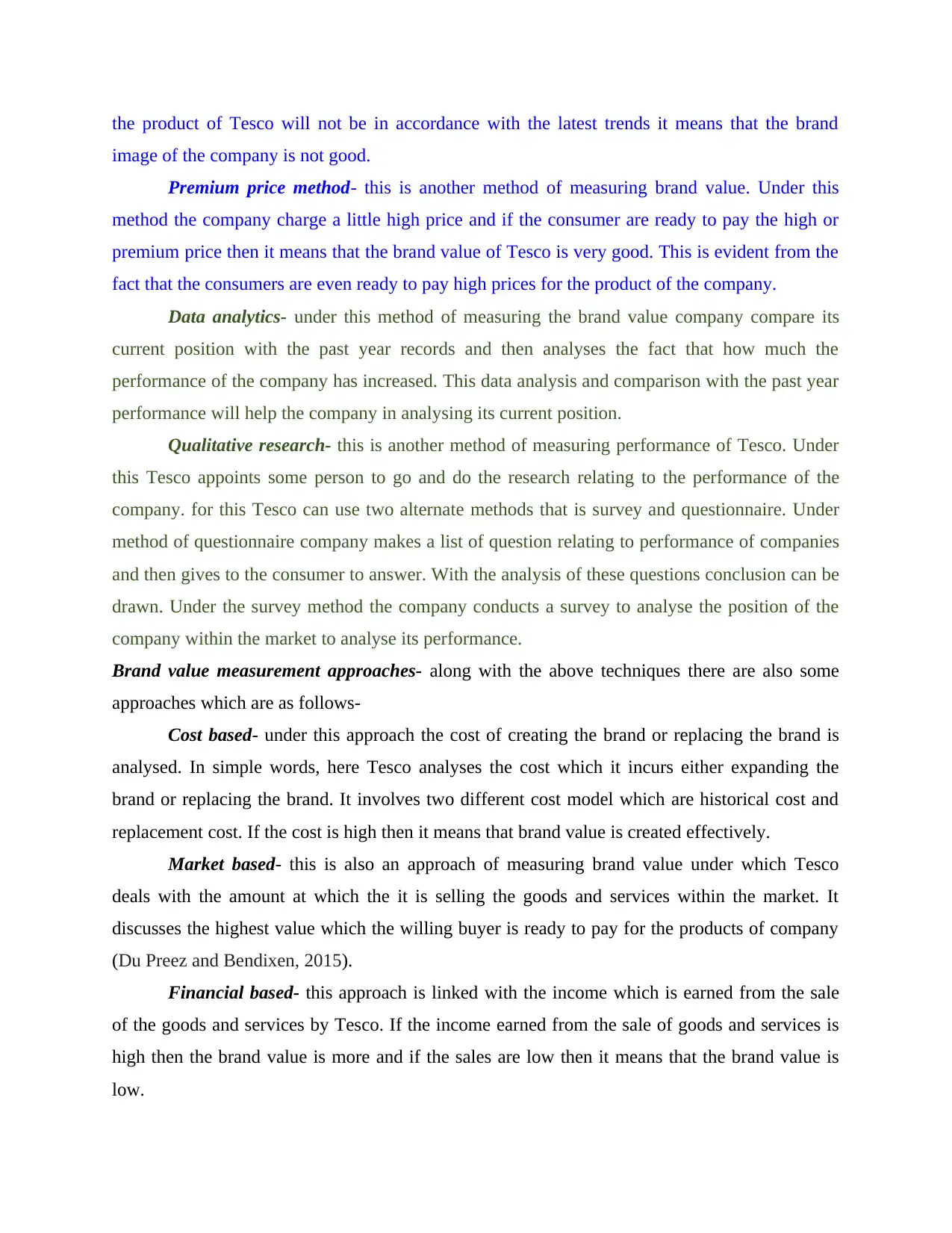
the product of Tesco will not be in accordance with the latest trends it means that the brand
image of the company is not good.
Premium price method- this is another method of measuring brand value. Under this
method the company charge a little high price and if the consumer are ready to pay the high or
premium price then it means that the brand value of Tesco is very good. This is evident from the
fact that the consumers are even ready to pay high prices for the product of the company.
Data analytics- under this method of measuring the brand value company compare its
current position with the past year records and then analyses the fact that how much the
performance of the company has increased. This data analysis and comparison with the past year
performance will help the company in analysing its current position.
Qualitative research- this is another method of measuring performance of Tesco. Under
this Tesco appoints some person to go and do the research relating to the performance of the
company. for this Tesco can use two alternate methods that is survey and questionnaire. Under
method of questionnaire company makes a list of question relating to performance of companies
and then gives to the consumer to answer. With the analysis of these questions conclusion can be
drawn. Under the survey method the company conducts a survey to analyse the position of the
company within the market to analyse its performance.
Brand value measurement approaches- along with the above techniques there are also some
approaches which are as follows-
Cost based- under this approach the cost of creating the brand or replacing the brand is
analysed. In simple words, here Tesco analyses the cost which it incurs either expanding the
brand or replacing the brand. It involves two different cost model which are historical cost and
replacement cost. If the cost is high then it means that brand value is created effectively.
Market based- this is also an approach of measuring brand value under which Tesco
deals with the amount at which the it is selling the goods and services within the market. It
discusses the highest value which the willing buyer is ready to pay for the products of company
(Du Preez and Bendixen, 2015).
Financial based- this approach is linked with the income which is earned from the sale
of the goods and services by Tesco. If the income earned from the sale of goods and services is
high then the brand value is more and if the sales are low then it means that the brand value is
low.
image of the company is not good.
Premium price method- this is another method of measuring brand value. Under this
method the company charge a little high price and if the consumer are ready to pay the high or
premium price then it means that the brand value of Tesco is very good. This is evident from the
fact that the consumers are even ready to pay high prices for the product of the company.
Data analytics- under this method of measuring the brand value company compare its
current position with the past year records and then analyses the fact that how much the
performance of the company has increased. This data analysis and comparison with the past year
performance will help the company in analysing its current position.
Qualitative research- this is another method of measuring performance of Tesco. Under
this Tesco appoints some person to go and do the research relating to the performance of the
company. for this Tesco can use two alternate methods that is survey and questionnaire. Under
method of questionnaire company makes a list of question relating to performance of companies
and then gives to the consumer to answer. With the analysis of these questions conclusion can be
drawn. Under the survey method the company conducts a survey to analyse the position of the
company within the market to analyse its performance.
Brand value measurement approaches- along with the above techniques there are also some
approaches which are as follows-
Cost based- under this approach the cost of creating the brand or replacing the brand is
analysed. In simple words, here Tesco analyses the cost which it incurs either expanding the
brand or replacing the brand. It involves two different cost model which are historical cost and
replacement cost. If the cost is high then it means that brand value is created effectively.
Market based- this is also an approach of measuring brand value under which Tesco
deals with the amount at which the it is selling the goods and services within the market. It
discusses the highest value which the willing buyer is ready to pay for the products of company
(Du Preez and Bendixen, 2015).
Financial based- this approach is linked with the income which is earned from the sale
of the goods and services by Tesco. If the income earned from the sale of goods and services is
high then the brand value is more and if the sales are low then it means that the brand value is
low.
Secure Best Marks with AI Grader
Need help grading? Try our AI Grader for instant feedback on your assignments.
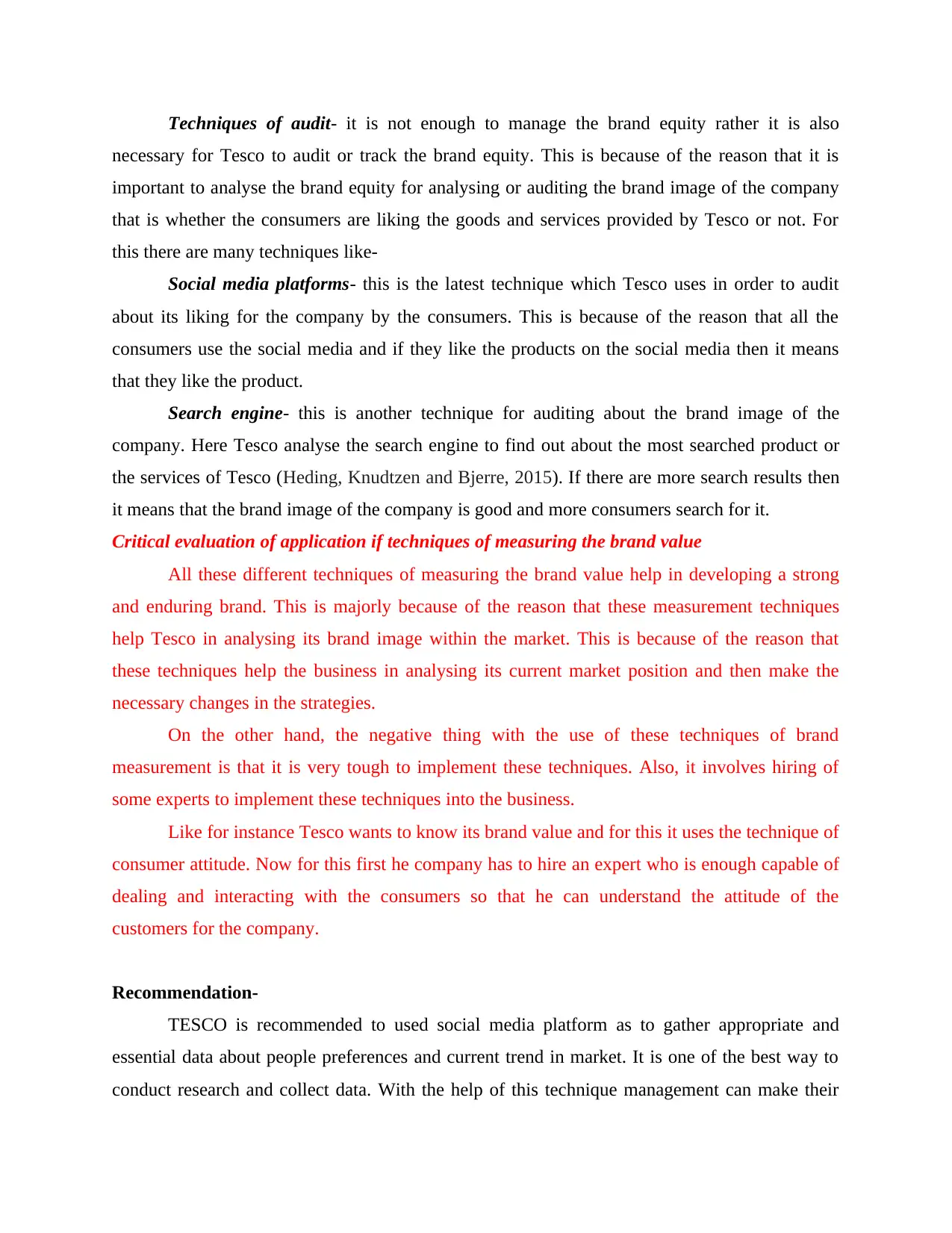
Techniques of audit- it is not enough to manage the brand equity rather it is also
necessary for Tesco to audit or track the brand equity. This is because of the reason that it is
important to analyse the brand equity for analysing or auditing the brand image of the company
that is whether the consumers are liking the goods and services provided by Tesco or not. For
this there are many techniques like-
Social media platforms- this is the latest technique which Tesco uses in order to audit
about its liking for the company by the consumers. This is because of the reason that all the
consumers use the social media and if they like the products on the social media then it means
that they like the product.
Search engine- this is another technique for auditing about the brand image of the
company. Here Tesco analyse the search engine to find out about the most searched product or
the services of Tesco (Heding, Knudtzen and Bjerre, 2015). If there are more search results then
it means that the brand image of the company is good and more consumers search for it.
Critical evaluation of application if techniques of measuring the brand value
All these different techniques of measuring the brand value help in developing a strong
and enduring brand. This is majorly because of the reason that these measurement techniques
help Tesco in analysing its brand image within the market. This is because of the reason that
these techniques help the business in analysing its current market position and then make the
necessary changes in the strategies.
On the other hand, the negative thing with the use of these techniques of brand
measurement is that it is very tough to implement these techniques. Also, it involves hiring of
some experts to implement these techniques into the business.
Like for instance Tesco wants to know its brand value and for this it uses the technique of
consumer attitude. Now for this first he company has to hire an expert who is enough capable of
dealing and interacting with the consumers so that he can understand the attitude of the
customers for the company.
Recommendation-
TESCO is recommended to used social media platform as to gather appropriate and
essential data about people preferences and current trend in market. It is one of the best way to
conduct research and collect data. With the help of this technique management can make their
necessary for Tesco to audit or track the brand equity. This is because of the reason that it is
important to analyse the brand equity for analysing or auditing the brand image of the company
that is whether the consumers are liking the goods and services provided by Tesco or not. For
this there are many techniques like-
Social media platforms- this is the latest technique which Tesco uses in order to audit
about its liking for the company by the consumers. This is because of the reason that all the
consumers use the social media and if they like the products on the social media then it means
that they like the product.
Search engine- this is another technique for auditing about the brand image of the
company. Here Tesco analyse the search engine to find out about the most searched product or
the services of Tesco (Heding, Knudtzen and Bjerre, 2015). If there are more search results then
it means that the brand image of the company is good and more consumers search for it.
Critical evaluation of application if techniques of measuring the brand value
All these different techniques of measuring the brand value help in developing a strong
and enduring brand. This is majorly because of the reason that these measurement techniques
help Tesco in analysing its brand image within the market. This is because of the reason that
these techniques help the business in analysing its current market position and then make the
necessary changes in the strategies.
On the other hand, the negative thing with the use of these techniques of brand
measurement is that it is very tough to implement these techniques. Also, it involves hiring of
some experts to implement these techniques into the business.
Like for instance Tesco wants to know its brand value and for this it uses the technique of
consumer attitude. Now for this first he company has to hire an expert who is enough capable of
dealing and interacting with the consumers so that he can understand the attitude of the
customers for the company.
Recommendation-
TESCO is recommended to used social media platform as to gather appropriate and
essential data about people preferences and current trend in market. It is one of the best way to
conduct research and collect data. With the help of this technique management can make their
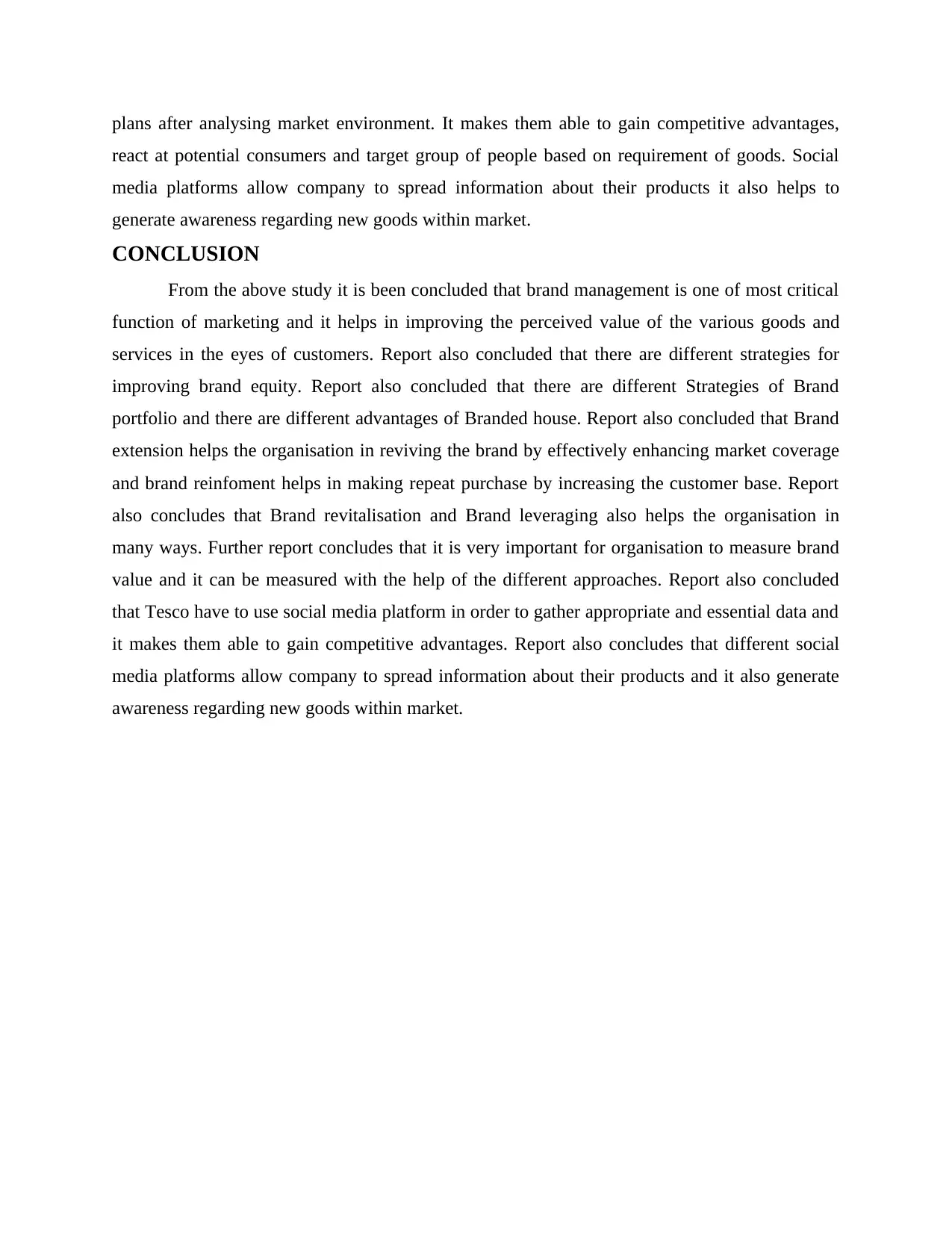
plans after analysing market environment. It makes them able to gain competitive advantages,
react at potential consumers and target group of people based on requirement of goods. Social
media platforms allow company to spread information about their products it also helps to
generate awareness regarding new goods within market.
CONCLUSION
From the above study it is been concluded that brand management is one of most critical
function of marketing and it helps in improving the perceived value of the various goods and
services in the eyes of customers. Report also concluded that there are different strategies for
improving brand equity. Report also concluded that there are different Strategies of Brand
portfolio and there are different advantages of Branded house. Report also concluded that Brand
extension helps the organisation in reviving the brand by effectively enhancing market coverage
and brand reinfoment helps in making repeat purchase by increasing the customer base. Report
also concludes that Brand revitalisation and Brand leveraging also helps the organisation in
many ways. Further report concludes that it is very important for organisation to measure brand
value and it can be measured with the help of the different approaches. Report also concluded
that Tesco have to use social media platform in order to gather appropriate and essential data and
it makes them able to gain competitive advantages. Report also concludes that different social
media platforms allow company to spread information about their products and it also generate
awareness regarding new goods within market.
react at potential consumers and target group of people based on requirement of goods. Social
media platforms allow company to spread information about their products it also helps to
generate awareness regarding new goods within market.
CONCLUSION
From the above study it is been concluded that brand management is one of most critical
function of marketing and it helps in improving the perceived value of the various goods and
services in the eyes of customers. Report also concluded that there are different strategies for
improving brand equity. Report also concluded that there are different Strategies of Brand
portfolio and there are different advantages of Branded house. Report also concluded that Brand
extension helps the organisation in reviving the brand by effectively enhancing market coverage
and brand reinfoment helps in making repeat purchase by increasing the customer base. Report
also concludes that Brand revitalisation and Brand leveraging also helps the organisation in
many ways. Further report concludes that it is very important for organisation to measure brand
value and it can be measured with the help of the different approaches. Report also concluded
that Tesco have to use social media platform in order to gather appropriate and essential data and
it makes them able to gain competitive advantages. Report also concludes that different social
media platforms allow company to spread information about their products and it also generate
awareness regarding new goods within market.
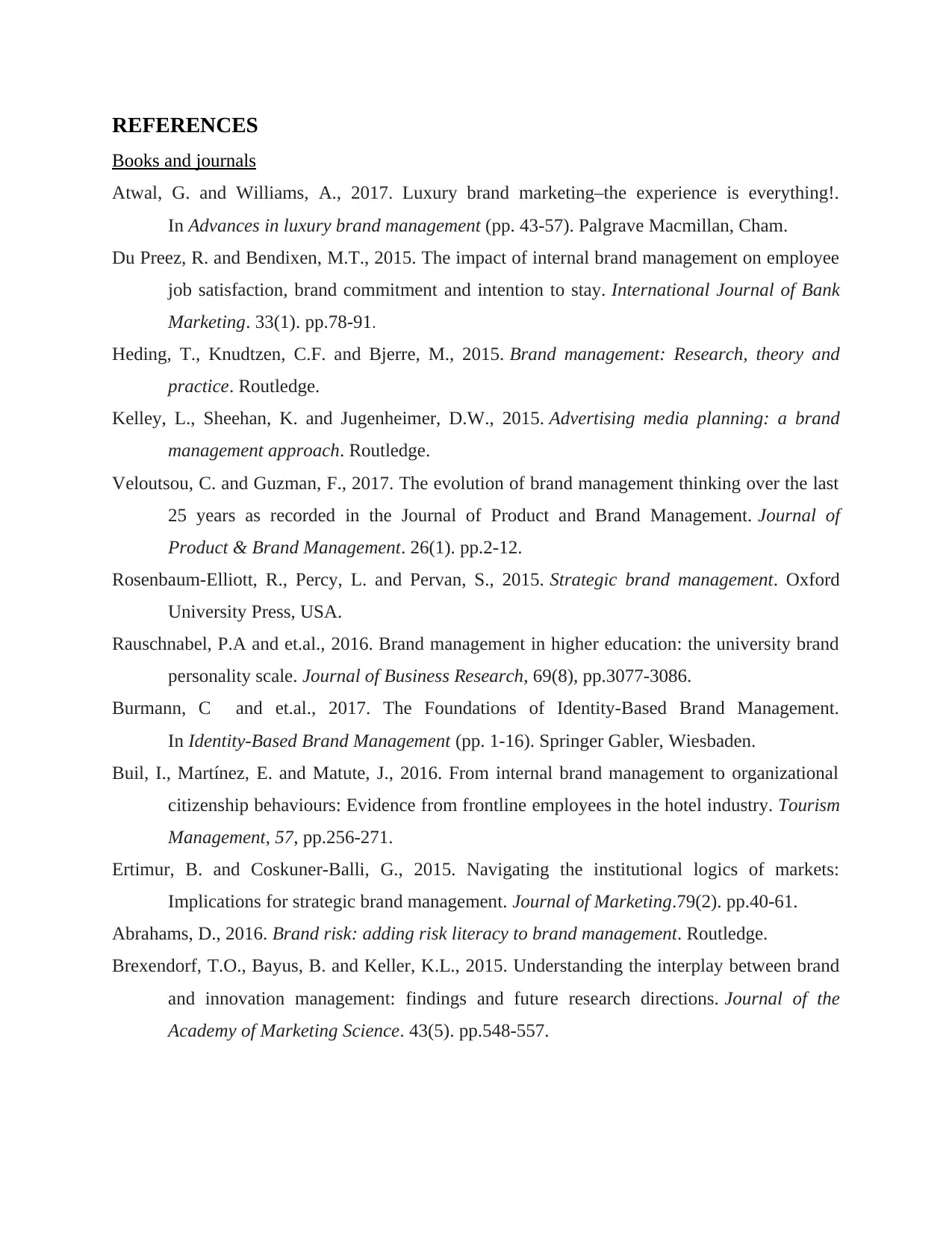
REFERENCES
Books and journals
Atwal, G. and Williams, A., 2017. Luxury brand marketing–the experience is everything!.
In Advances in luxury brand management (pp. 43-57). Palgrave Macmillan, Cham.
Du Preez, R. and Bendixen, M.T., 2015. The impact of internal brand management on employee
job satisfaction, brand commitment and intention to stay. International Journal of Bank
Marketing. 33(1). pp.78-91.
Heding, T., Knudtzen, C.F. and Bjerre, M., 2015. Brand management: Research, theory and
practice. Routledge.
Kelley, L., Sheehan, K. and Jugenheimer, D.W., 2015. Advertising media planning: a brand
management approach. Routledge.
Veloutsou, C. and Guzman, F., 2017. The evolution of brand management thinking over the last
25 years as recorded in the Journal of Product and Brand Management. Journal of
Product & Brand Management. 26(1). pp.2-12.
Rosenbaum-Elliott, R., Percy, L. and Pervan, S., 2015. Strategic brand management. Oxford
University Press, USA.
Rauschnabel, P.A and et.al., 2016. Brand management in higher education: the university brand
personality scale. Journal of Business Research, 69(8), pp.3077-3086.
Burmann, C and et.al., 2017. The Foundations of Identity-Based Brand Management.
In Identity-Based Brand Management (pp. 1-16). Springer Gabler, Wiesbaden.
Buil, I., Martínez, E. and Matute, J., 2016. From internal brand management to organizational
citizenship behaviours: Evidence from frontline employees in the hotel industry. Tourism
Management, 57, pp.256-271.
Ertimur, B. and Coskuner-Balli, G., 2015. Navigating the institutional logics of markets:
Implications for strategic brand management. Journal of Marketing.79(2). pp.40-61.
Abrahams, D., 2016. Brand risk: adding risk literacy to brand management. Routledge.
Brexendorf, T.O., Bayus, B. and Keller, K.L., 2015. Understanding the interplay between brand
and innovation management: findings and future research directions. Journal of the
Academy of Marketing Science. 43(5). pp.548-557.
Books and journals
Atwal, G. and Williams, A., 2017. Luxury brand marketing–the experience is everything!.
In Advances in luxury brand management (pp. 43-57). Palgrave Macmillan, Cham.
Du Preez, R. and Bendixen, M.T., 2015. The impact of internal brand management on employee
job satisfaction, brand commitment and intention to stay. International Journal of Bank
Marketing. 33(1). pp.78-91.
Heding, T., Knudtzen, C.F. and Bjerre, M., 2015. Brand management: Research, theory and
practice. Routledge.
Kelley, L., Sheehan, K. and Jugenheimer, D.W., 2015. Advertising media planning: a brand
management approach. Routledge.
Veloutsou, C. and Guzman, F., 2017. The evolution of brand management thinking over the last
25 years as recorded in the Journal of Product and Brand Management. Journal of
Product & Brand Management. 26(1). pp.2-12.
Rosenbaum-Elliott, R., Percy, L. and Pervan, S., 2015. Strategic brand management. Oxford
University Press, USA.
Rauschnabel, P.A and et.al., 2016. Brand management in higher education: the university brand
personality scale. Journal of Business Research, 69(8), pp.3077-3086.
Burmann, C and et.al., 2017. The Foundations of Identity-Based Brand Management.
In Identity-Based Brand Management (pp. 1-16). Springer Gabler, Wiesbaden.
Buil, I., Martínez, E. and Matute, J., 2016. From internal brand management to organizational
citizenship behaviours: Evidence from frontline employees in the hotel industry. Tourism
Management, 57, pp.256-271.
Ertimur, B. and Coskuner-Balli, G., 2015. Navigating the institutional logics of markets:
Implications for strategic brand management. Journal of Marketing.79(2). pp.40-61.
Abrahams, D., 2016. Brand risk: adding risk literacy to brand management. Routledge.
Brexendorf, T.O., Bayus, B. and Keller, K.L., 2015. Understanding the interplay between brand
and innovation management: findings and future research directions. Journal of the
Academy of Marketing Science. 43(5). pp.548-557.
Paraphrase This Document
Need a fresh take? Get an instant paraphrase of this document with our AI Paraphraser

Tatoglu, E., Demirbag, M. and O’Reilly, D., 2016. 7. brand management practices in an
emerging country market. Handbook of Contemporary Research on Emerging Markets,
p.153.
Keller, K.L. and Brexendorf, T.O., 2016. Strategic Brand Management Process. Handbuch
Markenführung, pp.1-22.
Bieger, T. and Sonderegger, P., 2017. Getting University brand Management right. Global
Focus: the EFMD business magazine.11(1).pp.52-55.
John, D.R. and Torelli, C.J., 2017. Strategic brand management: Lessons for winning brands in
globalized markets. Oxford University Press.
Punjaisri, K. and Wilson, A., 2017. The role of internal branding in the delivery of employee
brand promise. In Advances in corporate branding (pp. 91-108). Palgrave Macmillan,
London.
Zhang, Y., 2015. The impact of brand image on consumer behavior: A literature review. Open
journal of business and management. 3(1).
Online
The Importance of Branding to Customer Experience. 2019. [ONLINE]. Available
through:<https://blogs.oracle.com/cx/the-importance-of-branding-to-customer-experience-
v2>
Why Branding is important to Retail Product Manufacturers. 2016. [ONLINE]. Available
through:<https://retailbound.com/why-branding-is-important-to-retail-product-
manufacturers/>
Seven Components of a Successful Brand Strategy. 2014. [ONLINE]. Available
through:<http://blog.maxwellandmiller.com/blog/seven-components-of-a-successful-
brand-strategy>
emerging country market. Handbook of Contemporary Research on Emerging Markets,
p.153.
Keller, K.L. and Brexendorf, T.O., 2016. Strategic Brand Management Process. Handbuch
Markenführung, pp.1-22.
Bieger, T. and Sonderegger, P., 2017. Getting University brand Management right. Global
Focus: the EFMD business magazine.11(1).pp.52-55.
John, D.R. and Torelli, C.J., 2017. Strategic brand management: Lessons for winning brands in
globalized markets. Oxford University Press.
Punjaisri, K. and Wilson, A., 2017. The role of internal branding in the delivery of employee
brand promise. In Advances in corporate branding (pp. 91-108). Palgrave Macmillan,
London.
Zhang, Y., 2015. The impact of brand image on consumer behavior: A literature review. Open
journal of business and management. 3(1).
Online
The Importance of Branding to Customer Experience. 2019. [ONLINE]. Available
through:<https://blogs.oracle.com/cx/the-importance-of-branding-to-customer-experience-
v2>
Why Branding is important to Retail Product Manufacturers. 2016. [ONLINE]. Available
through:<https://retailbound.com/why-branding-is-important-to-retail-product-
manufacturers/>
Seven Components of a Successful Brand Strategy. 2014. [ONLINE]. Available
through:<http://blog.maxwellandmiller.com/blog/seven-components-of-a-successful-
brand-strategy>

1 out of 21
Related Documents
Your All-in-One AI-Powered Toolkit for Academic Success.
+13062052269
info@desklib.com
Available 24*7 on WhatsApp / Email
![[object Object]](/_next/static/media/star-bottom.7253800d.svg)
Unlock your academic potential
© 2024 | Zucol Services PVT LTD | All rights reserved.





